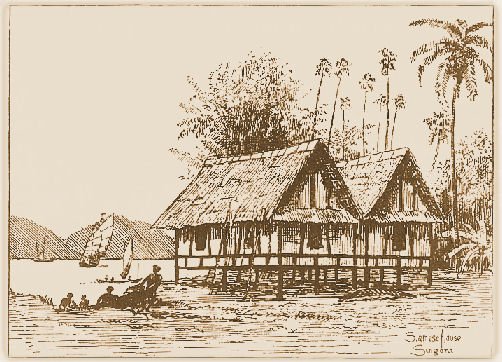

Kompiliert von Alois Payer
Zitierweise | cite as:
Payer, Alois <1944 - >: Bambus als Material. -- 4. Nutzung. -- (Architektur für die Tropen). -- Fassung vom 2010-01-10. -- URL: http://www.payer.de/tropenarchitektur/troparch034.htm
Erstmals veröffentlicht: 2009-10-14
Überarbeitungen: 2010-01-10 [Verbesserungen]
©opyright: Creative Commons Licence (by, no commercial use) (für Zitate und Abbildungen gelten die dort jeweils genannten Bedingungen)
Dieser Text ist Teil der Abteilungen Architektur und Entwicklungsländerstudien von Tüpfli's Global Village Library
น้ำชา gewidmet
|
Arquitectura cultivable Grow your own house
|
Diese Kompilation will nur Denkanstöße geben. Für den baumeisterlichen Umgang mit Bambus muss die angegebene Literatur sowie die Erfahrung von Fachleuten herangezogen werden.
Dieses Kapitel hat großteils nicht direkt mit Bambus als Baumaterial zu tun. Es soll einen kleinen Eindruck von den unzähligen Weisen geben, in denen Bambus verwendet wurde und wird. Manche dieser Nutzungen können einer phantasievollen Architektin zur Anregung sein, wie man Bambus in der Architektur neuartig verwenden könnte.
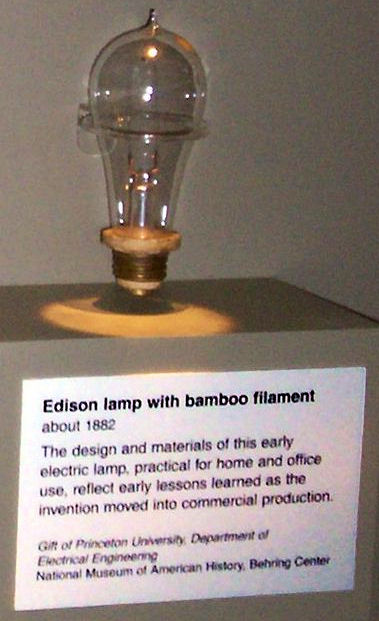
Abb.: Glühlampe von Thomas Alva Edison (1847 - 1931) Glühfaden aus
verkohlter Bambusfaser, um 1882
[Bildquelle: Wikipedia. -- Public domain]
Eine Übersicht der FAO von 2007 nennt folgende Nutzungen von Bambus:
"BAMBOO PRODUCT STATISTICS OVERVIEW
Forest resources are experiencing increasing pressure due to the growing world population and improving living standards. Bamboo is the most important non-wood forest product and in India is known as the ‘poor man’s timber’. In China, it is the valuable raw material for the booming bamboo industry.
During the last 15–20 years, bamboo has developed as an exceptionally valuable and often superior substitute for wood. Bamboo-based panels and boards are hard and durable and may successfully substitute for hardwood products. Bamboo may replace wood in many industrial applications and thereby contribute to the saving and restoration of the world’s forests.
Bamboo is a major construction material in many countries, particularly in rural areas. It can be used for almost all parts of houses, including posts, roofs, walls, floors, beams, trusses and fences. People also use bamboo to produce mats, baskets, tools, handles, hats, traditional toys, musical instruments and furniture. In the food sector, bamboo shoots are becoming more popular. Bamboo has a tremendous potential for economic and environmental development and international trade.
Bamboo raw materials
Bamboo is a non-durable resource. Its use in exposed conditions requires prior treatment (Liese and Kumar, 2003), while its use can be further enhanced through the application of modern engineering techniques. Bamboo can be processed into modern products (engineered bamboo) that may successfully compete with wood products in price and performance. Use of bamboo in composite panels and boards overcomes differences in quality related to the culms and allows the production of homogeneous products. Engineered bamboo may well replace wood, steel and concrete in many uses.
Bamboo charcoal
Bamboo charcoal is traditionally used as a substitute for wood charcoal or mineral coal. It can serve as a fuel, absorbent and conductor. The calorific value of bamboo charcoal is almost half that of oil of the same weight. Activated bamboo charcoal can be used for cleaning the environment, absorbing excess moisture and producing medicines. The absorption capacity of bamboo charcoal is six times that of wood charcoal of the same weight. China is a leader in its production. At present, Japan, the Republic of Korea and Taiwan Province of China are the main consumers, but its importation is rapidly expanding in Europe and North America. There are three main reasons contributing to the success of bamboo charcoal in international trade:
bamboo grows faster and has a shorter rotation compared with tree species;
the calorific value and absorption properties of bamboo charcoal are similar to or better than those of wood charcoal; and
it is cheaper and easier to produce.
Abb.: Bambus-Holzkohle mit Soda
[Bildquelle: lili.chin. -- http://www.flickr.com/photos/lilita/3989559612/. -- Zugriff am 2009-10-08. -- Creative Commons Lizenz (Namensnennung, keine kommerzielle Nutzung, keine Bearbeitung)]Bamboo housing
There are three main types of bamboo housing:
traditional houses, which use bamboo culms as a primary building material;
traditional bahareque bamboo houses, in which a bamboo frame is plastered with cement or clay; and
modern prefabricated houses made of bamboo laminated boards, veneers and panels.
Experts estimate that over one billion people live in traditional bamboo houses. These buildings are usually cheaper than wooden houses, light, strong and earthquake resistant, unlike brick or cement constructions. New types of prefabricated houses made of engineered bamboo have certain advantages. They can be packed flat and transported long distances at a reasonable cost. They are better designed and environmentally friendly. Bamboo materials are widely available and can be cultivated at a low cost. [S. 32]
Bamboo pulp, paper and cloth
Several bamboo-producing countries, such as China and India, use bamboo in pulp, paper and more recently cloth. Bamboo paper has practically the same quality as paper made from wood. Its brightness and optical properties remain stable, while those of paper made from wood may deteriorate over time. The morphological characteristics of bamboo fibres yield paper with a high tear index, similar to that of hardwood paper. The tensile stiffness is somewhat lower compared with softwood paper. The strain strength is between that of hardwood and softwood papers. The quality of bamboo paper may be improved by refining the pulp.
Abb.: Cai Lun ( 蔡伦) <50 - 121 n.Chr.>: Fünf Schritte der Papierherstellung aus Bambus
[Quelle des animated gif: Wikipedia. -- Public domain]Bamboo panels
China started producing bamboo panels in the early 19th century. At present more than 20 different types of panels are produced in Asia. Bamboo fibre is longer than wood fibre, which gives bamboo some technological advantages. The panels are widely used in modern construction as structural elements or as forms for concrete moldings. They are also used for flooring, roofing, partitions, doors and window frames. Bamboo panels have some advantages over wooden boards due to their rigidity and durability. Various types of bamboo veneers, panels and boards can be broadly classified as follows: veneers, strip-boards, mat-boards, fibre-boards, particle boards, medium density boards, combinations of these, and combinations of these with wood and other ligno-cellulose materials and inorganic substances.
Bamboo flooring
Bamboo flooring is a quality product that can be used widely and has a large, global consumer market. It has certain advantages over wooden floors due to its smoothness, brightness, stability, high resistance, insulation qualities and flexibility. Bamboo flooring has a soft natural luster and maintains the natural gloss and elegance of bamboo fibre. This flooring is attractive to the demanding markets in Europe, Japan and North America. The estimated annual production of bamboo flooring in China was 17.5 million m² in 2004. Exports account for some 65 percent of total production (Customs General Administration of China, 2004).
Abb.: Bambus-Fußboden[Bildquelle: Dirse. -- http://picasaweb.google.com/lh/view?q=bamboo&psc=G&filter=1&imglic=creative_commons#5361131131478138770 . -- Creatrive Commons Lizenz(Namensnnenung, keine kommerzielle Nutzung, keine Bearbeitung)]
Bamboo weaving products and crafts
Bamboo crafts and woven mats are traditional products in China, India, Malaysia, the Philippines and Thailand. The technique has been known for several thousand years. These diverse products have become an indispensable part of daily life, literature and art. There are nearly 20 categories of woven bamboo products in Asia, including fruit baskets, trays, bottles, jars, boxes, cases, bowls, fans, screens, curtains, cushions, lampshades and lanterns.
Abb.: Bambus-Wandschirm[Bildquelle: HoangTan.8m.com. -- http://picasaweb.google.com/lh/view?q=bamboo&psc=G&filter=1&imglic=creative_commons#5289275806657093250 . -- Zugriff am 2009-09-30. -- Creative Commons Lizenz (Namensnennung, keine Bearbeitung)]
Bamboo fuel
Through pyrolysis, bamboo can be converted into three valuable products: bamboo charcoal, oil and gas. Changing the pyrolysis parameters can change the product shares depending on the purpose and market conditions. Bamboo extracts contain valuable elements and can be used in pharmaceuticals, creams and beverages. Bamboo gas can be used as a substitute for petroleum. Bamboo charcoal is an excellent fuel for cooking and barbequing. Activated charcoal is used as a deodorant, purifier disinfectant, medicine, agricultural chemical and absorbent of pollution and excessive moisture.
Bamboo shoots
About 200 species of bamboo can provide edible and palatable bamboo shoots, including:
monopodial bamboos: Acidosasa edulis, Chimonobambusa quadrangularis, Phyllostachys heterocycla var. pubescens, P. praecox, P. dulcis, P. iridescens, P. makinoi, P. nuda, P. prominens, P. sulphurea cv. viridis, P. vivax, Pleioblastus amarus and Qiongzhuea tumidinoda; and
sympodial bamboos: Bambusa rigida, B. pervariabilis, Dendrocalamus latiflorus, D. asper, D. brandisii, D. hamiltonii, Dendrocalamopsis oldhami, D .beecheyana, D. beecheyana var. pubescens, D. stenoaurita, D. vario-striata and Schizostachyum funghomii.
Fresh bamboo shoots are delicious and healthy, with a high fibre content. Bamboo vegetables can be found in Chinese grocery stores and restaurants [S. 33] worldwide. After cooking the shoots are still crisp, because cooking does not destroy their texture. Cooked bamboo shoots can be stored in containers and shipped worldwide.
Bamboo furniture
Traditional bamboo furniture uses natural round or split bamboo. A new type of ‘pack-flat,’ ‘knockdown’ furniture uses glue-laminated bamboo panels. Unlike the traditional design, this furniture may be shipped in compact flat packs, to be assembled on the spot. The new design overcomes many of the problems of traditional bamboo furniture, such as high labour and transportation costs, low productivity, instability, varying quality and susceptibility to insects and fungi. At the same time, it retains the distinct physical, mechanical, chemical, environmental and aesthetic features of bamboo. Export of laminated bamboo furniture is growing rapidly. However, trade statistics currently do not capture the value, owing to the absence of a special code for bamboo furniture. It is usually classified as wooden furniture.
Abb.: Bambustisch, München, Deutschland
[Bildquelle: kogakure. -- http://www.flickr.com/photos/kogakure/18665730/. -- Zugriff am 2009-10-08. -- Creative Commons Lizenz (Namensnennung, keine kommerzielle Nutzung, share alike)Bamboo and culture
Bamboo is an important resource, which was discovered, adopted and developed by humans in ancient times. The first scripts were written in China on strips of bamboo more than 6 000 years ago, during the Neolithic period. Bamboo pens, brushes and musical instruments were invented 3 000 years ago. The first paper was produced from bamboo in China in the ninth century. Bamboo culture is an essential part of human history and civilization, especially in Asia.
Abb.: Malakas and Maganda, das erste Menschenpaar, das nach philippinischer Mythologie aus einem gespaltenen Bambus entsprungen ist
[Bildquelle: Marcelo Chan / Bambooman, LLC / Wikipedia. -- Creative Commons Lizenz (Namensnennung)]Bamboo and the environment
Bamboo protects steep slopes, soils and water ways, prevents soil erosion, provides carbon sequestration and brings many other ecosystem benefits."
[Quelle: World bamboo resources : a thematic study prepared in the framework of the Global Forest Resouces Assessment 2005 / by Maxim Lobovikov ... [et al]. -- Rome : Food and Agriculture Organization of the United Nations, 2007. -- XII, 73 S. : Ill. ; 30 cm. -- ISBN 9789251057810. -- (Non-wood forest products ; 18). -- S. 31 - 33. -- Online: http://209.85.129.132/search?q=cache:1BaZTYLslLQJ:www.fao.org/docrep/010/a1243e/a1243e00.HTM+%22world+bamboo+resources%22&cd=1&hl=de&ct=clnk&gl=de. -- Zugriff am 2009-09-28]
Es folgen drei historische Beschreibungen der Nutzung von Bambus:
Fedor Jagor beschreibt sehr lebendig die Nutzung des Bambus in Südostasien und China:
"Als wir nach kaum zwei Stunden den Pasanggrahan wieder betraten, fanden wir Alles wie durch Zauber verändert. Das vorher so stille Gehöft war jetzt voll Leben und Tätigkeit, und noch immer kamen neue Züge von Kulis und trugen allerlei Gegenstände der Bequemlichkeit herbei. In den Schuppen waren die Pferde der Häuptlinge untergebracht; auf dem Hofe brannten mehrere Feuer, an denen emsig gekocht und gebraten wurde. Eine große Anzahl Arbeiter waren beschäftigt, frisch gefällte Bambussen vermittelst ihrer Haumesser in allerlei Möbel, Haus- und Küchengerät zu verwandeln. Zwei große bequeme Lehnstühle waren bereits vollendet, und eben wurde die letzte Hand an einen Tisch gelegt, dessen Platte aus Bambussplissen bestand. Als Leuchter dienten Bambusse von entsprechendem Durchmesser, die einen Zoll hoch über einem Knoten abgeschnitten waren, während das entgegengesetzte längere Ende in drei Teile gespalten, auseinandergespreizt, durch Querstäbe verbunden und mit einem Stein beschwert, den Fuß bildete. Andere Arbeiter waren beschäftigt, das Dach auszubessern. In dem länglich viereckigen, vorher so unwohnlichen Raum, der uns zum Aufenthalt dienen sollte, waren an beiden Enden durch bunte Vorhänge zwei kleine Gemächer abgetrennt worden; in jedem stand bereits ein Bett aufgeschlagen ; der ganze mittlere Teil, unser Salon, war mit weichen Pandanusmatten belegt, und sobald wir gebadet, wurde auf dem nun vollendeten Tische ein vortreffliches Essen aufgetragen mit sehr mannigfaltigem Dessert, worauf Kaffee mit Cognac folgte. Es war fast wie das „Tischchen deck' dich" im Märchen. Je länger man in diesen Ländern verweilt, um so mehr wächst das Erstaunen über die unzähligen nützlichen Verwendungen einiger Pflanzen, unter denen der Kokospalme und dem Bambus wohl die erste Stelle gebührt.
Abb.: Häusergruppe in einem Gebirgsdörfchen, JavaAus Bambus baut der Javaner sein Haus, aus Bambus bestehen alle seine Möbel; in einer Bambusröhre, die dabei zwar verkohlt, aber nicht verbrennt, kocht er auf Reisen seinen Reis an einem Bambusfeuer, wenn er nicht etwa vorzieht, junge Bambustriebe, die ein sehr schmackhaftes Gemüse geben, darin zu kochen.
Wie schon mehrmals angedeutet, besteht oft das ganze Gerüst des Hauses aus Bambus; die Wände aus plattgedrückten geflochtenem Halmen [S. 175] ; die Dächer werden zwar gewöhnlich mit Palmenblättern oder Gras gedeckt, aber auch mit Bambusschindeln, die wie Hohlziegel gelegt werden. Einige mit Wasser gefüllte, von der Dachfirste paarweise herabhängende geräumige Internodien bilden einen stets bereiten Löschapparat. Schuppen, Ställe, Scheunen, fast sämtliches Ackergerät, sowie der Zaun um das Gehöft, bestehen aus Bambus. In einem unter dem Dach horizontal aufgehängten, an einem Ende mit einem Loch versehenen Halm siedelt sich die kleine stachellose Biene an, die dem Javanern das Wachs liefert, das er, wie später beschrieben werden soll, bei dem Färben seiner Sarongs gebraucht. Zuweilen ist in einem ganzen Dörfchen kaum ein anderes Material verwendet; der zierliche Zaun, der es umgibt, die Tore an beiden Enden, mit erhöhten Bänken, auf welchen die Wache lagert, alles ist aus Bambus; neben letzterer hängt in mehreren Exemplaren ein eigentümliches Instrument zum Fangen der Diebe und Bösewichte ; es besteht aus zwei armdicken Bündeln dünner Seitenzweige des dornigen Bambus, die gabelförmig an einer Stange befestigt sind und dazu dienen, den Verfolgten am Halse zu packen.
In vielen malayischen Ländern, wo der Fluss die einzige Strasse durch den dichten Wald bildet, erheben sich am Ufer und namentlich an den schlammigen Mündungen Gruppen von Hütten auf Pfählen (vergl. die Ansicht von Rochor). Wie bei den alten Pfahlbauten sind sie häufig durch eine gemeinschaftliche Galerie verbunden. Wenn nicht zu den Pfählen Palmenstämme (gewöhnlich Caryota urens) verwendet sind, so besteht Alles aus Bambus. Nirgends springt einem die Bequemlichkeit des Lebens der Tropenbewohner mehr in die Augen, als in dergleichen Ansiedelungen, (vergl. S. 50 unten.)
Abb.: Rochor, SingaporeFast die ganze mehrere hunderttausend Seelen betragende Bevölkerung der Hauptstadt von Siam [สยาม, heute Thailand] lebt in Häusern, die auf Bambusflössen schwimmen, und in meilenlangen Reihen zu beiden Seiten des Flusses und der Kanäle am Ufer festgemacht sind. Gefällt Einem seine Nachbarschaft nicht, so schwimmt er mit der Ebbe oder Flut stromab- oder aufwärts.
Für alle Arten von Gestellen, Gerüsten, Gittern, Rahmen ist der Bambus unübertrefflich ; außer der gewöhnlichen Leiter erhält man eine etwas weniger bequeme, aber viel tragbarere durch bloßes Einhauen von Löchern in den Halm. Er liefert ebensowohl die zierlichen Käfige für kleine Singvögel oder Prachtkäfer, als auch die großen, in denen bei Festlichkeiten Tiger und Büffel kämpfen.
Soll in Hongkong ein großes [S. 176] steinernes Haus gebaut werden, so führt man erst ein den äußern Umrissen ähnliches größeres Gebäude aus Bambus auf, und deckt es mit Bambus- oder Palmenblättern, unter deren schützendem Dache dann die Arbeit, unbehindert durch Regen oder Sonnenglut, um so schneller fortschreitet.
Steinerne Theater sind, wie ich glaube, in ganz China nicht vorhanden; selbst das Theater in Canton [廣州], das eine große Zuschauermenge fasst, bestand nur aus Bambus.
Allerlei Hausrat, Stühle, Tische, Webestühle, Betten sind von Bambus ; das lange krause Geschabsel dient zum Polstern ; kühlere und elastischere Kissen erhält man, indem man eine feine Bambus- oder Rotangmatte über zwei in ihren Mittelpunkten an den Enden eines Stabes befestigte Scheiben straff spannt. Nicht nur die Hütte der Armen ist mit Bambus möbliert, auch in der Wohnung des Reichen findet man ihn in Form bequemer Schlummerstühle und in allerlei zierlichen Gerätschaften wieder. Vor der Veranda hängen Rollvorhänge aus feingespaltenen, durch Seidenfäden aneinandergeknüpften Stäbchen, die zwar die Luft durchlassen, aber, namentlich wenn sie dunkelgrün gefärbt sind, das Licht angenehm dämpfen. Dort findet man auch die zierlichsten Körbchen und künstlich geschnitzte Becher. Die lackierten Bambusdosen von Birma sind berühmt und in Palembang überzieht man Körbe aus dünnen Bambusspänen mit einem Lack, der so elastisch ist, dass man sie völlig umstülpen kann, ohne dass Sprünge entstehen.
Ein Span von keilförmigem Querschnitt, dessen scharfe Kante von der kieselreichen äußeren Schicht gebildet wird, gibt ein sehr scharfes Messer; bei den feinen Pina-Webereien benutzt man nie ein anderes. Auch zu chirurgischen Operationen wird es verwendet. Dieselbe äußere Schicht liefert aber nicht nur ein scharfes Messer, sondern auch einen sehr wirksamen Wetzstein, um eiserne Messer zu schärfen.
In China wird das meiste Papier aus Bambus erzeugt, auch das in Europa für Kunstdrucke so geschätzte. Bei den Pinseln, die in China die Schreibfedern vertreten, bestehen die Schäfte aus Bambus; gröbere Pinsel macht man sich leicht, indem man das eine Ende eines Bambussplints so lange mit dem Hammer klopft, bis sich die einzelnen Längsfasern trennen.1
1 Andere endogene Pflanzen, besonders Pandaneen, liefern aber auf diese Weise noch bessere Pinsel ; in den Philippinen dienen diese allgemein zum Tünchen der Wände.
Für die Jagd und den Krieg liefert der Bambus Blasröhre, aus denen vergiftete Pfeile geschossen werden, Pfeilschäfte und Pfeilspitzen, [S. 177] Lanzen, Palisaden, spanische Reiter, auch Fußlanzen (6" bis 2' lange, zugeschärfte Bambusspieße, die so in den Boden gesteckt werden, dass nur die Spitzen hervorragen, welche mit Spreu oder lockerer Erde bedeckt, dem barfüssigen Feinde gefährliche Wunden beibringen). Der Dornenbambus , eine bis 40' hohe, sehr dickbuschige, vielverzweigte, überall mit scharfen Stacheln bewehrte Art, bildet einen undurchdringlichen Wall, gegen den selbst Artillerie kaum etwas vermag, so dass die Holländer, durch ihre Erfahrungen im Kriege gegen die Padrys auf Sumatra belehrt, ihn jetzt immer um ihre eigenen Festungen pflanzen.
Dem Fischer liefert der Bambus unübertreffliche Flösse, Masten, Segelstangen, Spreizen für Mattensegel, Reusen, Fangkörbe, Speere zum Spießen großer Fische und „Ausleger", um sein schmales Boot gegen Umschlagen zu schützen. Zu diesem Zwecke wählt man etwas bogenförmige Halme, die dem Boot parallel, die konvexe Seite nach unten, in Entfernung einiger Ellen vermittelst zweier Querstangen befestigt werden. Je nach der Stärke des Windes taucht das Rohr auf der Leeseite mehr oder weniger tief ein und stützt das Fahrzeug.
Abb.: Bambusbrücke, JavaDie Verwendung des Bambus zu Brücken geht am besten aus den Zeichnungen hervor,1 außerdem aber baut man auch solche, die floßartig im Wasser liegen. In Bambussen, deren Enden in einander gefügt sind, leitet man das Wasser große Strecken weit über Berg und Tal.
1 Siehe auch: Brücke bei Wonosobo.
Abb.: Brücke aus Bambus und Rotang, Wonosobo, JavaEine kletternde, sehr zähe, dünne Art liefert gespalten, allerlei feines Flechtwerk, auch Stricke, sogar Säcke. Ja selbst Jacken machen die Chinesen aus einer kleinen Art, indem sie die Seitentriebe von der Dicke eines Rabenkiels in halbzoll lange Stücke schneiden, wie Schmelzperlen auf Fäden ziehen und zu quadratischen Maschen verknüpfen. Chinesische Stutzer tragen gern dergleichen Jacken auf dem bloßen Körper, um ihr weißes baumwollenes Gewand gegen Schweiß zu schützen. Aus Bambusblättern bestehen die Regenmäntel der Armen und die groben Regenschirme der Höker. Die unter dem Namen Pfefferrohr in Deutschland bekannten Stöcke und Regenschirmstiele sind Bambus. Bei den chinesischen und japanischen Schirmen besteht das ganze Gestell aus Bambussplissen, und der Überzug aus gefirnisstem Papier.
Geht man in den Wald auf eine Exkursion, so sind die Kulis schwer zu bewegen, Tragkörbe mitzunehmen, da eine Bambusse alles Nötige liefert, um Körbe, Kiepen, Tragen u. s. w. in kürzester Zeit zu flechten. Zur [S. 178] Bewahrung kleiner oder flüssiger Gegenstände dienen unmittelbar die Internodien. Auch die amtlich geeichten Maße für Flüssigkeiten und Körner bestehen daraus.
In einem Bambusbusch stecken Musikinstrumente für ein ganzes Orchester. Am naheliegendsten ist die Verwendung zu Flöten und Pfeifen. Wie die Mintras Gitarren daraus machen, ist bereits erwähnt. Auch die abscheuliche chinesische Fidel „hii-ïeng" besteht aus Bambus. (In ein 3—4" langes, 2" dickes, an einem Ende mit einer Schlangenhaut trommelartig bespanntes Rohr, welches den Körper der Geige bildet, ist seitlich ein etwa 2' langer Bambusstock eingelassen, an dessen oberem Ende die Wirbel für zwei Saiten angebracht sind; der Steg steht auf der Schlangenhaut.) Ein sehr angenehmes Instrument dagegen ist das Anklung, bestehend aus einer Anzahl Rohre von graduierter Länge, die an einem Gestell hängen und durch Aneinanderstoßen in tönende Schwingungen versetzt werden. Logan erwähnt einer Art Äolsharfe, die er in Naning sah und den Triumph der malayischen Kunst nennt : „Denn was könnte kühner und sinnreicher sein als der Gedanke, einen ganzen Bambus frisch aus dem Walde 30—40' lang durch einfaches Einschneiden einiger Löcher in ein musikalisches Instrument zu verwandeln."
Für religiöse Zwecke liefert der Bambus auf den Philippinen Kirchen, Kapellen und Kreuze. (Für die Erziehung ist der Rotang beliebter und wird stark benutzt. Das Sprichwort sagt: für jeden Inder, der geboren wird, sprießen im Walde tausend Rotangs auf.) Die Chinesen schneiden aus seinen knorrigen, struppigen Wurzeln phantastische Figuren für den Tempel und den Hausaltar. Aus Bambuswurzeln bestehen auch die eigentümlichen Wurfhölzer in den Tempeln, durch welche die Chinesen das Schicksal befragen, um aus der Art des Fallens auf den Erfolg einer Unternehmung zu schließen; in ihrer Zudringlichkeit werfen sie aber die Hölzer so lange, bis sie endlich eine günstige Antwort erhalten.
Auch als Feuerzeug ist der Bambus in Gebrauch, und wohl allen andern bei den Wilden üblichen Feuerzeugen vorzuziehen. Man spaltet einen recht trockenen Halm von 2—3' der Länge nach in der Mitte, schabt aus den Innern Wandungen die silberglänzende weiche Haut und das weiche Holz so fein als möglich und rollt das Geschabsel zu einer losen Kugel zusammen , die auf den Boden gelegt und mit der einen Hälfte des Halms bedeckt wird, so dass sie oben gegen die Wölbung drückt. Von der andern Hälfte spaltet man dann noch einen Streifen ab, so dass ein fast flaches lattenförmiges Stück zurückbleibt, dessen eine Seite zugeschärft wird. Mit dieser Seite geigt man auf dem Bambus, [S. 179] der von einem Begleiter oder durch Pflöcke festgehalten wird, gerade über der Stelle, wo das feine Geschabsel liegt, hin und her, indem man allmählich den Druck und die Geschwindigkeit steigert. So entsteht ein Einschnitt quer durch die Längsfasern, die Wärme wächst bei der starken Reibung sehr schnell, und in dem Augenblick, wo das Gewölbe durchschnitten ist, entzündet sich das verkohlte Holzpulver zu Funken, die in den darunter liegenden Faserballen fallen und durch vorsichtiges Blasen allmählich zu einem Flämmchen genährt werden. Der Versuch ist leicht anzustellen und gelingt jedesmal, wenn alle Vorbereitungen richtig getroffen sind.
Endlich möchte ich noch einer schrecklichen Todesstrafe erwähnen, die früher auf Bali in Gebrauch gewesen sein soll. Die Bambussen wachsen außerordentlich schnell und dringen mit sehr harten kieselreichen Trieben, die wie Spitzkugeln geformt sind, aus dem Boden. Es wird erzählt, dass man, nachdem die längeren Halme entfernt worden, den Verbrecher horizontal über den Stumpfen aufspannte, um ihn von den jungen Trieben durchwachsen zu lassen.
Manche Bambusarten haben sehr dicke Wände im Verhältnis zu ihrem Durchmesser, andere sehr dünne, bei großem Umfang. Auf dem Abhang des Semeru (Ost-Java) maß ich sehr dünnwandige Bambussen von 70' Länge und 26" Umfang an der Basis (Junghuhn gibt deren von 1' Durchmesser an), die bis zur Spitze mit Wasser gefüllt waren. Diesem Wasser wird eine besondere Heilkraft zugeschrieben. In demselben lebt ein kleines krebsartiges Tier, das die Javanern Ikanwadr nennen, ich aber leider nicht auffinden konnte. Noch größere Heilkraft schreibt man den Kieselkonkretionen zu, die sich in manchen Bambussen bilden und unter dem Namen Tabaschir oder Bambuskampfer in den Handel kommen. Die große Rolle, die der Tabaschir in der chinesischen Medizin spielt, verdankt er wohl, wie die Bezoarsteine, seiner spontanen Entstehung. Auch als Poliermittel wird der Tabaschir gebraucht; große Quantitäten gehen nach Arabien, ihre dortige Verwendung konnte ich aber nicht ermitteln.
Von der Schönheit einer auf offenem Felde oder auf einer Anhöhe freistehenden Bambusse, deren oben reich befiederte Halme sich bei Windstille nach allen Seiten gleichmäßig zur Erde neigen, wie die Wassergarbe eines Springbrunnens, kann man sich nach den verkümmerten Exemplaren in den Ecken unserer engen Treibhäuser unmöglich einen Begriff machen. Sie übertrifft sowohl die Palme als den Baumfarn an landschaftlicher Schönheit. Es wäre ein würdiger Versuch für einen [S. 180] reichen Gartenfreund, seinen Rasenplatz mit einer Bambusgruppe zu schmücken. Ein gemauertes, durch Rühren heizbares Becken, mit einem im Sommer abzunehmenden Glashause würde genügen; vielleicht wären selbst einfachere Vorrichtungen ausreichend. (Im Garten der Fürstin Butera bei Palermo sah ich Bambussen im freien Lande, es war aber keine schöne Art.) Rings um die Mittelgruppe könnte man niedrigere Arten mit goldgelben und gelb und grün gestreiften Halmen setzen, deren es äußerst zierliche gibt. Die Auswahl ist endlos; die Dicke schwankt zwischen 1 Fuß und wenigen Millimetern, die Höhe erreicht 70 — 80', abgesehen von den kletternden, welche viel länger werden; die Farbe umfasst sehr verschiedene Töne von grün und gelb; es gibt auch gestreifte, gefleckte und schwarze; und es trifft sich glücklich, dass gerade die schönste aller Bambusarten im nördlichen China in einem Klima wächst, das von dem Süd-Europas nicht allzu verschieden ist. R. Fortune, der in diesem Punkt gewiss kompetent ist, glaubt wenigstens, dass sie in Süd-Frankreich, Italien und ähnlichen Gegenden im Freien gedeihen möchte. Er sagt von ihr (Residence among the Chinese pg. 189) : „Die Mau-tschok ist die schönste Bambusse der Welt — 60— 80' hoch. Stamm gerade, glatt, astlos bis auf 20 oder 30' vom Boden, der obere, belaubte Teil so leicht und gefiedert, dass er die Reinheit des Stammes nicht beeinträchtigt." Wie alle andre Arten dieser Gruppe wachsen sie sehr schnell und erreichen ihre volle Höhe in wenigen Monaten; man sieht sie fast wachsen, wie man zu sagen pflegt. Fortune, der häufige Messungen in den chinesischen Bambuswäldern anstellte, fand, dass eine gesunde Pflanze 2—2½' in 24 Stunden wächst, und zwar Nachts am schnellsten. Selbst im Treibhause ist ihr Wachstum enorm. Hr. Inspektor Bouche berichtet, dass eine im freien Grunde des Palmenhauses im Berliner botanischen Garten stehende Bambusa verticillata vom 22. Juni bis Anfang Oktober 38' emporschoss. Vom 28. Juni bis 4. August wurde sie täglich gemessen und wuchs 10' in 38 Tagen, also durchschnittlich 3½ Zoll, an einzelnen sehr warmen Tagen aber 7, ja sogar 9 Zoll."
[Quelle: Jagor, Fedor <1816-1900>: Singapore, Malacca, Java. Published. -- Berlin, J. Springer, 1866. -- 252 S. : Ill. -- 25 cm. -- S. 174 - 180. -- Online: http://www.archive.org/details/singaporemalacca00jago . -- Zugriff am 2009-10-05]
Baron Freeman-Mitford gibt eine plastische Beschreibung der Nutzung von Bambus in Asien und Europa:
CHAPTER
IV: USES, CUSTOMS, SUPERSTITIONSTHERE is not in the whole vegetable kingdom a plant which is so intimately bound up with the life of mankind as the Bamboo. In India, Ceylon, China, Japan, the Malay Archipelago, and in the tropical forests the world over it is a servant-of-all-work.
More than one case is recorded where the abundant seeds of the Bamboo have been the means of staving off the horrors of an Indian famine. In Orissa, in 1812, when one of those rare general flowerings of the Bamboo, to which allusion has been made, took place, there was famine in the land. The seeds of the Bamboo, cooked and eaten like rice, gave their only food to many thousands. Day and night the people watched to gather the precious fruit as it fell. Mr. Shaw Stewart, the collector of Canara [Kanara / Karavali - ಕರಾವಳಿ], on the western coast of India, states that "In 1864 there was a general flowering of the Bamboo in the Soopa jungles, and a very large number of persons, estimated at 50,000, came from the Dharwar [ಧಾರವಾಡ] and Belgaum [ಬೆಳಗಾವಿ] districts to collect the seed. Each party remained about ten or fourteen days, taking away enough for their own consumption during the monsoon months, as well as some for sale," and adds, that " the flowering was a most [S. 28] providential benefit during the prevalent scarcity." Mr. Gray, writing from Malda [English Bazaar - ইংলিশবাজার] in 1866, says, "In the south district, throughout the whole tract of country, the Bamboo has flowered, and the seed has been sold in the bazaar at thirteen seers (26 Ibs.) for three rupees, rice being ten seers, the ryots having stored enough for their own wants in addition. Hundreds of maunds (the maund being 100 lbs.) have been sold in the English bazaar at Malda, and large quantities have been sent to Sultangunge and other places 25 to 30 miles distant, showing how enormous the supply must have been." Mr. Gray adds, "The Bamboo harvest has been quite providential, as the ryots were on the point of starving." [Munro, p. 4] Sir Joseph Hooker in his Himalayan Journals, p. 107 (ed. 1891) says : "The young shoots of several (Bamboos) are eaten, and the seeds of one are made into a fermented drink, and into bread in times of scarcity ; but it would take many pages to describe the numerous purposes to which the various species are put." His account of the ingenious way in which his Lepcha servants used to improvise huts and furniture on his travels in little more than an hour, with no handier tool than a long knife, is most curious and interesting. Near the top of a pass from the Teesta [टिस्टा] to the great Rungeet he found "a plant of Praong (a small Bamboo) in full seed ; this sends up many flowering branches from the root and but few leaf-bearing ones, and after maturing its seed and giving off suckers from the root, the parent plant dies. The fruit is a dark, long grain, like Rice ; it is boiled and made into cakes, or into beer like Murwa" (Ib. p. 220). [S. 29]
To the Chinaman, as to the Japanese, the Bamboo is of supreme value; indeed, it may be said that there is not a necessity, a luxury, or a pleasure of his daily life to which it does not minister. It furnishes the framework of his house and thatches the roof over his head, while it supplies paper for his windows, awnings for his sheds, and blinds for his veranda. His beds, his tables, his chairs, his cupboards, his thousand and one small articles of furniture are made of it. Shavings and shreds of Bamboos are used to stuff his pillows and his mattresses. The retail dealer's measures, the carpenter's rule, the farmer's water-wheel and irrigating pipes, cages for birds, crickets, and other pets, vessels of all kinds, from the richly lacquered flower-stands of the well-to-do gentleman down to the humblest utensils, the wretchedest duds of the very poor, all come from the same source. The boatman's raft, and the pole with which he punts it along ; his ropes, his mat-sails, and the ribs to which they are fastened; the palanquin in which the stately mandarin is borne to his office, the bride to her wedding, the coffin to the grave ; the cruel instruments of the executioner, the lazy painted beauty's fan and parasol, the soldier's spear, quiver, and arrows, the scribe's pen, the student's book, the artist's brush and the favourite study for his sketch ; the musician's flute, mouth-organ, plectrum, and a dozen various instruments of strange shapes and still stranger sounds in the making of all these the Bamboo is a first necessity. Plaiting and wicker-work of all kinds, from the coarsest baskets and matting down to the delicate filigree with which porcelain cups are encased so cunningly that it would seem as if no fingers less deft than those of fairies [S. 30] could have woven the dainty web are a common and obvious use of the fibre. The same material made into great hats like inverted baskets protects the coolie from the sun, while the labourers in the rice fields go about looking like animated haycocks in waterproof coats made of the dried leaves of Bamboo sewn together. See at the corner of the street a fortune-teller attracting a crowd around him as he tells the future by the aid of slips of Bamboo graven with mysterious characters and shaken up in a Bamboo cup, and every man around him smoking a Bamboo pipe. See in yonder cook-shop the son of Han regaling himself with a mess of Bamboo shoots, which have been cooked in a vessel of the same material coated with clay, and are eaten with chopsticks which may have grown on the same parent stem. Such shoots, either in the shape of pickles or preserved in sugar, are an article of export from south to north where they are esteemed a delicacy.
Then there is the famous medicine Tabashir, the great and infallible nostrum with which some Buddhist priest or Chinese Dulcamara will promise to heal you of every and any ailment. In certain Bamboos, especially, according to Roxburgh, in the Melocanna bambusoides [= Melocanna baccifera (Roxb.) Kurz], there is found in the cavities between the knots a substance consisting of silica with a little lime and vegetable matter, or sometimes of silica and potash in the proportion of about seventy parts of silica to thirty of potash. It is said to be formed by extravasation of the juices of the plant in consequence of some diseased condition of the nodes or joints. Beautifully opalescent, the loveliness of Tabashir is by the faithful regarded as only equalled by its medicinal virtues. Some [S. 31] idea of the quantity of silica contained in Bamboos may be gathered from the fact recorded that one species, Bambusa tabacaria, will emit sparks when struck with an axe.
House, furniture, art, clothes, arms, food, and medicine, what does this wonderful plant not supply ? And it is all so cheap, too ; for the materials of a common dwelling-house in the south of China cost about twenty-five dollars ! [Compare Williams' Middle Kitigdom, vol. i. p. 360.]
Near the Malay villages, where the houses are carried upon poles above the red teeming swamp, like the old lacustrine dwellings, there is sure to be a Bamboo grove. Towards evening, when the fresh sea-borne breeze drives the burning stillness of the day before it, bringing to the poor washed-out natives a faint renewal of energy, weird and ghostly strains come floating upon the air. It is no mortal music, for Æolus himself is the musician, rivalling the great god Pan of old. In one of the hollow stems of the grove holes have been pierced, some greater and some less, one in each joint; through these the Wind-God breathes fitful wailing sounds, now deep like the pedal notes of an organ, now soft as a fairy's flute. This is Bulu Perindu, the plaintive Bamboo, the analogue of the Æolian harp. [Compare Sir Emerson Tennant's Ceylon, vol. i. ; Munro, p. 2.]
Strange to say, the Bamboo played an important, though, fortunately, inconspicuous, part in the history of European industry. In the sixth century, when Justinian was reigning at Constantinople, the court reserved to itself a monopoly of the silk trade and of its manufacture, the looms being worked by women in the Imperial Palace. Up to that time the silkworms that feed upon the leaves of the white [S. 32] Mulberry were confined to China ; those which haunt the Pine, the Oak, and the Ash were common in the forests both of Asia and Europe, but as their education is more difficult and their produce more uncertain, they were generally neglected, except in the little island of Ceos [Κέως], near the coast of Attica. The Persians had the monopoly of the trade in Chinese silk. This was a matter of deep concern to Justinian, who endeavoured to procure the raw material for his looms through his adventurous Christian allies, the Abyssinians, who at that time were a naval and commercial power. His negotiations failed, the Abyssinians declining a competition with the Persians, whose proximity to India must give them an overwhelming advantage. Another expedient, however, presented itself. Two Persian monks, who had long been resident in China, travelled to Constantinople, a giant's journey, and proposed to the Emperor that they should endeavour to introduce the eggs of the silkworm into Europe. The offer was accepted and liberally encouraged by Justinian. The two monks returned to China, and by smuggling the eggs in the hollow of a cane contrived to elude the vigilance of the Chinese, and made their way safely to Constantinople with their precious treasure. It is not too much to say that in that fragment of Bamboo were carried the future commercial fortunes of Lyons, of Genoa, of Spitalfields, and all the other great manufactories of Europe, for from those eggs were descended all the races and varieties which stocked the Western World. But the pity of it is that we have not the record of the travels and adventures of those two Persian monks! This memorable importation is assigned to the year 552 A.D. (Gibbon, [S. 33] Decline and Fall of the Roman Empire, chap. xl. ; Encyclopedia Britannica, Article, "Silk").
There is one use which I would not recommend. One day in the north of China I was calling upon a French friend. I found him in his garden with a large gang of coolies, superintending the laying out of some new shrubberies and flower-beds. Knowing him to be ignorant of the language, I expressed my astonishment, and asked him how he managed to make them understand. " Ah ! mon cher," said the little man, shaking his cane viciously, "J'ai ici le meilleur interprète du monde -- le Professeur Bambou." Like some other interpreters, the Bamboo is apt in that capacity to lead to trouble.
It is to be regretted that, however well we may succeed in the cultivation of Bamboos for pleasure and ornament, the plant which is so rich in economic value in its own country is not likely to prove useful here. I consulted a leading London umbrella and stick maker on the subject, and he told me that in his trade they were obliged even to eschew the canes of the South of France as insufficiently ripened, and consequently liable to split. It would seem, then, that we must be contented with the beauty of our plants and ask no more of them than they can give ; but it is hard to think that out of so much wealth we cannot even achieve the humble triumph of an umbrella stick.
In his Note sur la culture du Bambou et ses usages industries dans la région des Pyrénées et dans le sud-ouest de la France (1878) M. Calvert, sub-inspector of forests, gives some interesting particulars as to the success which has attended the venture started by M. Guillemin in 1861 at Gan in the Basses Pyrénées. [S. 34] At that date the area under Bamboo cultivation was a slope of 4 hectares, or rather more than 9 acres, 350 metres above sea-level. The cost of planting was 3000 francs per acre. The plants reached maturity in from seven to eight years, at the end of which period the older shoots were removed for industrial purposes, bringing in a profit of from 800 to 1000 francs per hectare annually.
The species recommended for cultivation are NIGRA, used for umbrella sticks, sword canes, whip handles, fishing-rods, and various purposes ; MITIS, used for the same purposes as NIGRA, the rhizomes being used also for cups, napkin rings, egg-cups, goads for oxen, sticks for beating walnut and chestnut trees, etc. ; and MÉTAKÉ, of which are made pipe-stems, cigar and cigarette tubes, pen and pencil-holders, bird-calls, and other objects.
He gives the following list of objects with the prices actually obtained at Gan :
Francs. Bundles of bamboos in the rough for whip-handles without roots 50-00 per hundred Bundles dressed with roots 18-00 per dozen Parcels of bamboo whips with roots 60-00 per dozen without roots 48-00 per dozen Fishing-rods with top joints 0-50 per metre Spare top joints according to length from 30 to 50-00 per hundred Bundles of bamboos for umbrellas in the rough 10-00 per hundred dressed 100-00 per hundred Alpine sticks for tourists without roots 18-00 per dozen with roots 24-00 per dozen Ox-goads with spring point 12-00 per dozen mounted with iron 15-00 per dozen Handles for caterpillar destroyers 0-25 per metre Handles for extinguishers used in churches 0-25 per metre Handles for extinguishers used for gas 0-30 per metre Quoin sticks and frames 0-25 per metre [S. 35] Drinking cups 3-00 per dozen Napkin rings 1-50 per dozen Egg-cups 1-50 per dozen Paper-cutters 3-00 per dozen Shoe-horns 3-00 per dozen Tobacco pipes made of bamboo roots, prices varying from 3 to 10-00 each Paper made of stems and leaves of bamboo No price given Inkstands 3-00 per dozen Penholders in the rough 2-00 per hundred Stems of bamboo fit for paper-making No price given Canes known as "Java" (? Wang-hai) made of rhizomes from 2 to 5 each Canes known as "Queues de rnulet" made of the rhizomes which shoot up above ground from 2 to 5 each M. Calvert further notes the value of Bamboos for binding together with their rhizomes movable soil on sloping ground, a merit also pointed out by Messrs. Rivière in their monograph.
The economical results obtained at Gan might perhaps tempt some enterprising horticulturist or farmer in Devonshire or Cornwall to make an experiment of a similar nature. The cultivation of Bamboos is of the easiest; the plants renew themselves, new shoots taking the place of those which are cut; and a permanent profit of something like £16 per acre at the end of eight years is an alluring bait. But it must be remembered that since 1878 means of communication with the far East have vastly increased ; Bamboo canes are imported at a very low rate, and those ripened under a tropical or sub-tropical sun are, as I have already pointed out, tougher and more reliable than those even of the South of France.
Tough indeed the canes must be that are to make the frames of bicycles and tricycles. A report in one of the [S. 36] daily newspapers of a recent show of cycles says, "No one would credit, until after actual trial, the strength and rigidity which the bamboo cycles possess, coupled at the same time with a definite amount of increased comfort."
The latest honour achieved by a Bamboo is (according to a Birmingham paper) that of having furnished to a church in Shanghai (上海) a set of organ pipes which, for softness and mellowness of tone, outdo all others.
In the superstitions of the world the Bamboo has its place. Rumpf, who died in the year 1693, says, in his Herbarium Amboinense, that the Malays in his time believed that the first man sprang from the hollow stem of the Bamboo. The Garrows [Garos], a race inhabiting the western extremity of the mountain range at the bend of the Burrampooter, whom Sir Joseph Hooker describes in his Himalayan Journals as a savage race, given to human sacrifices and polyandry, are said by De Gubernatis in his Mythologie des Plantes to have neither temple nor altar. They erect before their huts a pillar of Bamboo, which they decorate with flowers and cotton and offer up sacrifice to the divinity in front of it.
In some Eastern countries the rarely recurrent flowering of the Bamboos is regarded as a sure presage of great calamity. The North Borneo Herald of 1st August 1894 has a paragraph upon the subject in connection with the terrible visitation of the plague which ravaged Hong-Kong in 1894.
"THE BLOOM ON THE BAMBOO
A Hong-Kong paper has the following note : The bloom on the Bamboo has indeed proved an unerring portent of evil in this year of disaster. It is well known as a rare phenomenon in the botanical world, and is always in the Oriental mind associated with impending [S. 37] calamity. After the Bamboo in the spring had flowered to an abnormal degree it was confidently predicted by the superstitious native that much evil was about to fall upon us. Unfortunately, only too true was the presentiment, for during many decades no more serious blow has fallen on the prosperity and happiness of the colony than the plague which manifested itself just as the swaying Bamboos burst into verdancy. Of course, it is quite possible that there is more in the belief that the flowering cane means ill than we might at first imagine. Such a phenomenon is doubtless due to abnormal atmospheric and climatic conditions, which, while causing the Bamboos to flower, may be also fertile to the development of various diseases. The index may therefore be more or less reliable, as reliable indeed as the data on which we foretell the weather."
The editor of the Hong-Kong paper might have added the Chinese-Japanese war as another disastrous sequel to the portent.
In the gay decorations with which the holiday-loving Japanese brighten their houses and streets in honour of the new year the Bamboo is a conspicuous feature. On the 28th or 29th day of the twelfth month the work of decoration begins. A Fir tree and a stem of Bamboo are planted on either side of the principal door of the house, and between them is hung a cord of straw. To this cord are suspended a boiled lobster, a piece of charcoal, a large Orange, a dried Persimmon [The fruit of Diospyrus kaki], a frond of Bracken, a leaf of the evergreen Oak, and a piece of seaweed, all tied together into a sort of bouquet. The Fir and the Bamboo are evergreen emblems of long life ; the lobster, strong in spite of its crooked back, is an emblem of bent, but hale old age ; the charcoal, which does not decay, represents imperishability ; the Orange, from its name, Dai-dai [橙], which by a pun means "from generation to generation," and from the fact of its being supposed to [S. 38] hang longer on the tree than any other fruit, is in like manner of auspicious omen ; the dried Persimmon, which long preserves its taste, represents the unchanged sweetness of conjugal love and fidelity ; the Bracken is held to be slow in fading ; the Oak leaf does not fall off the tree until the young leaf is ready to take its place, just as a father is happy who does not die until his son is fit to succeed him ; while the seaweed, Kompu or Kobu, composes the last two syllables of yorokobu [慶ぶ], "to be happy." The rope of straw represents the rope which the gods, after they had lured out the sun-goddess, according to the myth which in the Shinto religion springs from the first eclipse of the sun, hung outside the stone cave of heaven in order to prevent her from returning into it. These various emblems are hung up to propitiate the Year-God, praying him to preserve the house from evil during the ensuing twelve months. They are taken down on the seventh day of the first month, and on the fourteenth day they are burnt in honour of Sai no Kami [賽の神], the god of roads and protector of travellers. The origin of this custom is lost in antiquity. It is alluded to in the collection of poems called the "Hundred Heads," compiled by the Emperor Horikawa [堀河天皇] at the end of the eleventh century, where, in the poem by one of the nobles of the court named Akisuye [Fujiwara no Akisue 藤原顕季], is found the following passage : "When the Fir trees are placed at the doors we know that the night will break into the morning of the new year." Such customs do not grow in a day ; so it is fair to suppose that this one was already of respectable age 800 years ago."
[Quelle:Redesdale, A. B. (Algernon Bertram Freeman-Mitford, Baron) < 1837-1916>: The bamboo garden, by A. B. Freeman-Mitford ... illustrated by Alfred Parsons. -- London, New York, Macmillian, 1896. -- XI, 224 S. : Ill. ; 23 cm. -- S. 27 - 38. -- Online: http://www.archive.org/details/bamboogarden00redeiala . -- Zugriff am 2009-09-20
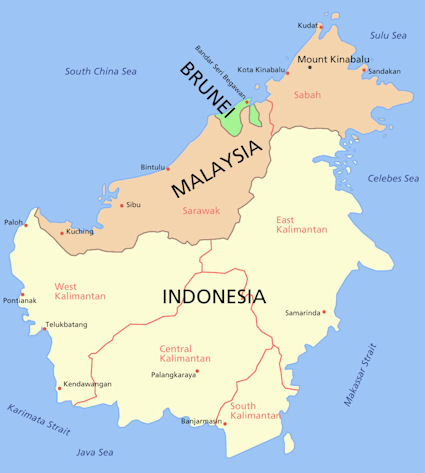
Abb.: Borneo, das Wohngebiet der Dayak (Dyak)
[Bildquelle: Roke / Wikipedia. -- GNU FDLicense]
Über die Verwendung von Bambus bei den Dayak in Borneo schreibt Alfred Russel Wallace <1823-1913> 1869:
"During my many journeys in Borneo, and especially during my various residences among the Dyaks, I first came to appreciate the admirable qualities of the bamboo. In those parts of South America which I had previously visited, these gigantic grasses were comparatively scarce, and where found but little used, their place being taken as to one class of uses by the great variety of palms, and as to another by calabashes and gourds. Almost all tropical countries produce bamboos, and wherever they are found in abundance, the natives apply them to a variety of uses. Their strength, lightness, smoothness, straightness, roundness, and hollowness, the facility and regularity with which they can be split, their many different sizes, the varying length of their joints, the ease with which they can be cut and with which holes can be made through them, their hardness outside, their freedom from any pronounced taste or smell, their great abundance, and the rapidity of their growth and increase, are all qualities which render them useful for a hundred different purposes, to serve which other materials would require much more labor and preparation. The bamboo is one of the most wonderful and most beautiful productions of the tropics, and one of nature's most valuable gifts to uncivilized man.
The Dyak houses are all raised on posts, and are often two or three hundred feet long and forty or fifty wide. The floor is always formed of strips split from large bamboos, so that each may be nearly flat and about three inches wide, and these are firmly tied down with rattan to the joists beneath. When well made, this is a delightful floor to walk upon barefooted, the rounded surfaces of the bamboo being very smooth and agreeable to the feet, while at the same time affording a firm hold. But, what is more important, they form with a [S. 88] mat over them an excellent bed, the elasticity of the bamboo and its rounded surface being far superior to a more rigid and a flatter floor. Here we at once find a use for bamboo which can not be supplied so well by another material without a vast amount of labor, palms and other substitutes requiring much cutting and smoothing, and not being equally good when finished. When, however, a flat, close floor is required, excellent boards are made by splitting open large bamboos on one side only, and flattening them out so as to form slabs eighteen inches wide and six feet long, with which some Dyaks floor their houses. These with constant rubbing of the feet and the smoke of years become dark and polished, like walnut or old oak, so that their real material can hardly be recognized. What labor is here saved to a savage whose only tools are an axe and a knife, and who, if he wants boards, must hew them out of the solid trunk of a tree, and must give days and weeks of labor to obtain a surface as smooth and beautiful as the bamboo thus treated affords him. Again, if a temporary house is wanted, either by the native in his plantation or by the traveller in the forest, nothing is so convenient as the bamboo, with which a house can be constructed with a quarter of the labor and time than if other materials are used.
As I have already mentioned, the Hill Dyaks in the interior of Sarawak make paths for long distances from village to village and to their cultivated grounds, in the course of which they have to cross many gulleys and ravines, and even rivers, or sometimes, to avoid a long circuit, to carry the path along the face of a precipice. In all these cases the bridges they construct are of bamboo, and so admirably adapted is the material for this purpose that it seems doubtful whether they ever would have attempted such works if they had not possessed it. The Dyak bridge is simple but well designed. It consists merely of stout bamboos crossing each other at the roadway like the letter X, and rising a few feet above it. At the crossing they are firmly bound together, and to a large bamboo which lays upon them and forms the only pathway, with a slender and often very shaky one to serve as a handrail. When a river is to be crossed, an overhanging tree is chosen, from which the bridge is partly suspended and partly [S. 89] supported by diagonal struts from the banks, so as to avoid placing posts in the stream itself, which would be liable to be carried away by floods. In carrying a path along the face of a precipice, trees and roots are made use of for suspension ; struts arise from suitable notches or crevices in the rocks, and if these are not sufficient, immense bamboos fifty or sixty feet long are fixed on the banks or on the branch of a tree below. These bridges are traversed daily by men and women carrying heavy loads, so that any insecurity is soon discovered, and, as the materials are close at hand, immediately repaired. When a path goes over very steep ground, and becomes slippery in very wet or very dry weather, the bamboo is used in another way. Pieces are cut about a yard long, and opposite notches being made at each end, holes are formed through which pegs are driven, and firm and convenient steps are thus formed with the greatest ease and celerity.
DYAK CROSSING A BAMBOO BRIDGE.It is true that much of this will decay in one or two seasons, but it can be so quickly replaced as to make it more economical than using a harder and more durable wood.
One of the most striking uses to which bamboo is applied by the Dyaks is to assist them in climbing lofty trees, by [S. 90] driving in pegs in the way I have already described at page 65. This method is constantly used in order to obtain wax, which is one of the most valuable products of the country. The honey-bee of Borneo very generally hangs its combs under the branches of the tappan, a tree which towers above all others in the forest, and whose smooth cylindrical trunk often rises a hundred feet without a branch. The Dyaks climb these lofty trees at night, building up their bamboo ladder as they go, and bringing down gigantic honey-combs. These furnish them with a delicious feast of honey and young bees, besides the wax, which they sell to traders, and with the proceeds buy the much-coveted brass wire, earrings, and gold-edged handkerchiefs with which they love to decorate themselves. In ascending durion and other fruit-trees which branch at from thirty to fifty feet from the ground, I have seen them use the bamboo pegs only, without the upright bamboo which renders them so much more secure.
The outer rind of the bamboo, split and shaved thin, is the strongest material for baskets ; hen-coops, bird-cages, and conical fish-traps are very quickly made from a single joint by splitting off the skin in narrow strips left attached to one end, while rings of the same material or rattan are twisted in at regular distances. Water is brought to the houses by little aqueducts formed of large bamboo split in half and supported on crossed sticks of various heights so as to give it a regular fall. Thin long-jointed bamboos form the Dyaks' only water-vessels, and a dozen of them stand in the corner of every house. They are clean, light, and easily carried, and are in many ways superior to earthen vessels for the same purpose. They also make excellent cooking utensils ; vegetables and rice can be boiled in them to perfection, and they are often used when travelling. Salted fruit or fish, sugar, vinegar, and honey are preserved in them instead of in jars or bottles. In a small bamboo case, prettily carved and ornamented, the Dyak carries his sirih and lime for betel-chewing, and his little long-bladed knife has a bamboo sheath. His favorite pipe is a huge hubble-bubble, which he will construct in a few minutes by inserting a small piece of bamboo for a bowl obliquely into a large cylinder about six inches from the bottom containing water, through which the [S. 91] smoke passes to a long slender bamboo tube. There are many other small matters for which bamboo is daily used, but enough has now been mentioned to show its value. In other parts of the Archipelago I have myself seen it applied to many new uses, and it is probable that my limited means of observation did not make me acquainted with one-half the ways in which it is serviceable to the Dyaks of Sarawak."
[Quelle: Wallace, Alfred Russel <1823-1913>: The Malay Archipelago: the land of the orang-utan, and the bird of paradise. A narrative of travel, with studies of man and nature. -- New York, Harper & Brothers, 1869. -- 638 S. Ill. ; 21 cm. -- S. 87 - 91. -- Online: http://www.archive.org/details/malayarchipelago00wall . -- Zugriff am 2009-09-22]
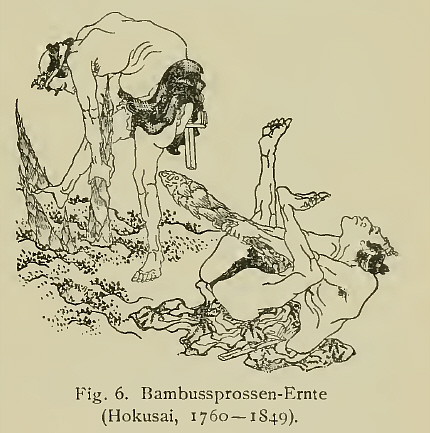
Abb.: Hokusai (北斎) <1760 - 1849>: Bambussprossen-Ernte
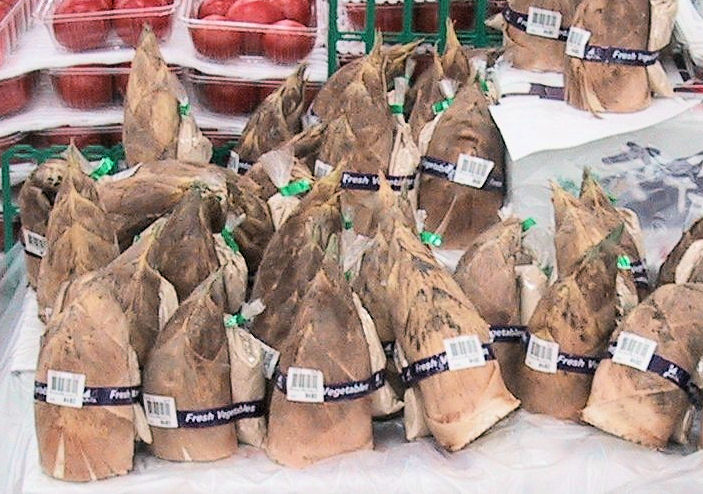
Abb.: Bambussprossen, Supermarket, Japan (日本)
[Bildquelle: Chris 73 / Wikipedia. -- GNU FDLicense]
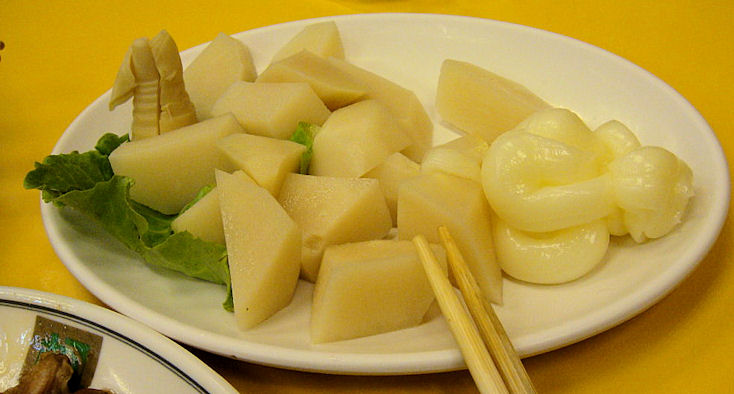
Abb.: Bambus-Snack, Taipei, Taiwan
[Bildquelle: DL5MDA / Wikipedia. -- Public domain]
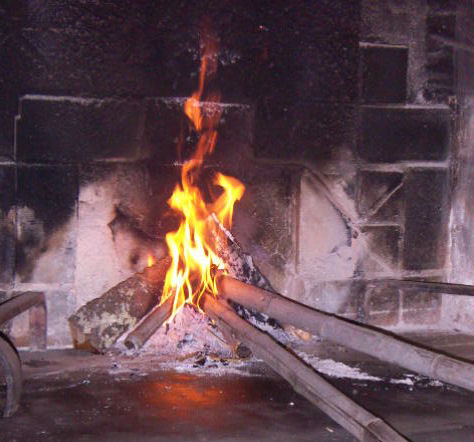
Abb.: Bambus als Brennmaterial
[Bildquelle: Jordi Coll Costa / Wikipedia. -- GNU FDLicense]
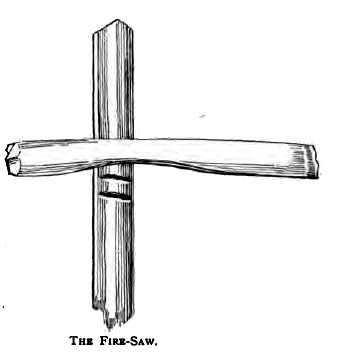
Abb.: Feuersäge aus zwei Bambusstücken, Dayak, Borneo
[Bildquelle: Roth. -- 1896]
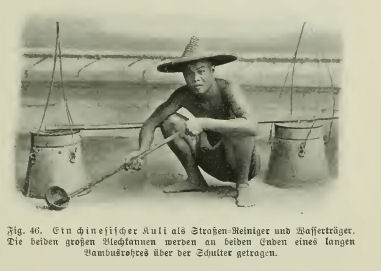
Abb.: Ernst Haeckel <1834 - 1919>: Ein chinesischer Kuli als
Straßenreiniger und Wasserträger [Java]. Die beiden großen Blechkannen werden an
beiden Enden eines langen Bambusrohrs über den Schultern getragen.
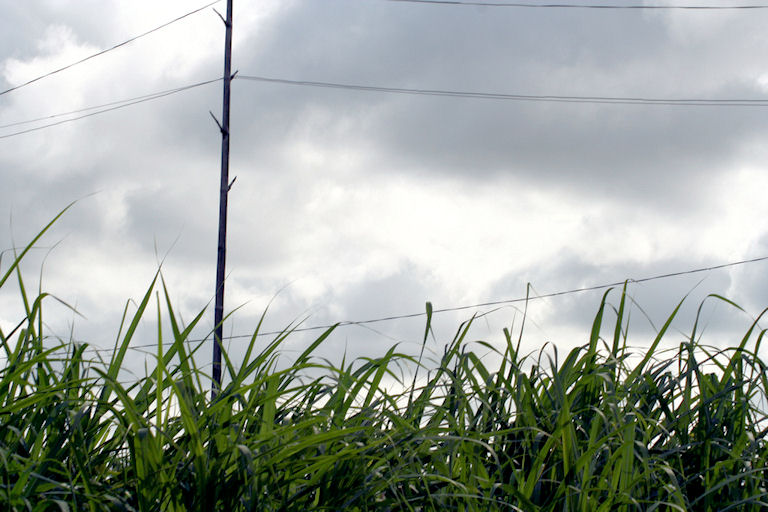
Abb.: Telefonleitung, Lungsod ng Bacolod, Philippinen
[Bildquelle: Jesse Gardner. --
http://www.flickr.com/photos/plasticmind/852069594/ . -- Zugriff am
2009-10-08. --
Creative Commons Lizenz (Namensnennung, share alike)]

Abb.: Trinkgefäße aus Bambus, Thailand (ประเทศไทย)
[Bildquelle: Clare & Dave. --
http://www.flickr.com/photos/clarebatemanking/146067805/. -- Zugriff am
2009-09-14. --
Creative
Commons Lizenz (Namensnennung, keine kommerzielle Nutzung, keine
Bearbeitung)]
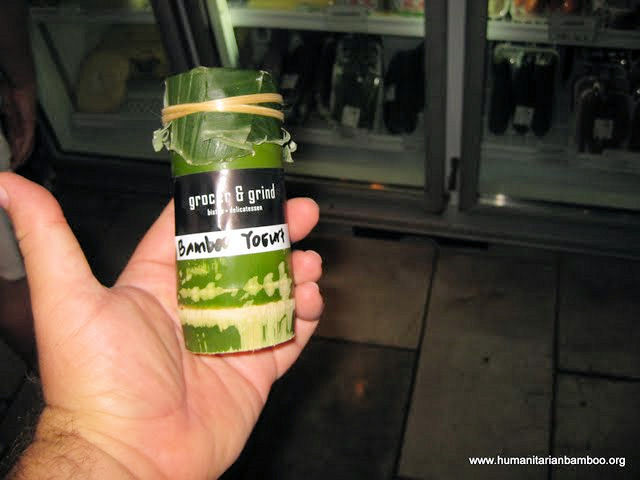
Abb.: Joghurtbecher aus Bambus
[Bildquelle: humanitarianbamboo.org. -- http://picasaweb.google.com/humanitarianbamboo/BambooYoghurt#5292507252003855426 . -- Zugriff am 2009-09-29. -- Creative Commons Lizenz (Namensnennung, keine kommerzielle Nutzung, share alike)]
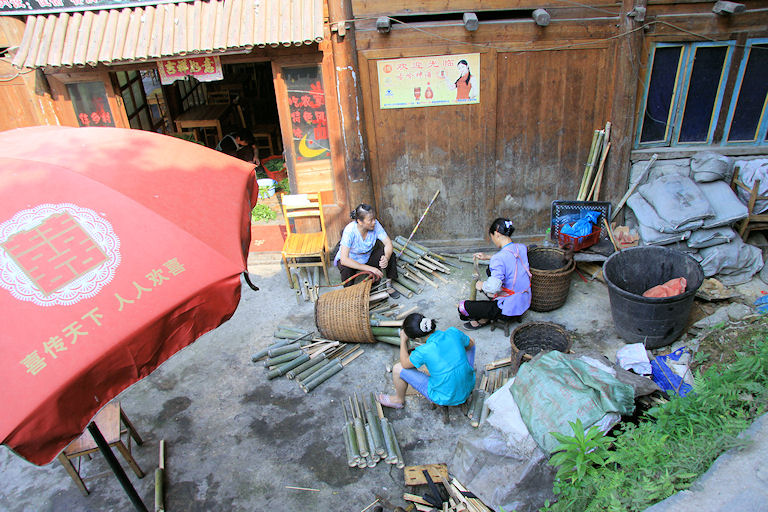
Abb.: Bearbeitung von Bambusstäben zum Reiskochen, Longsheng (龙胜梯田), Guilin (桂林),
China (中国)
[Bildquelle: Erwyn van der Meer. --
http://www.flickr.com/photos/erwyn/3796427087/ . -- Zugriff am 2009-09-13.
-- Creative
Commons Lizenz (Namensnennung, keine kommerzielle Nutzung, keine
Bearbeitung)]
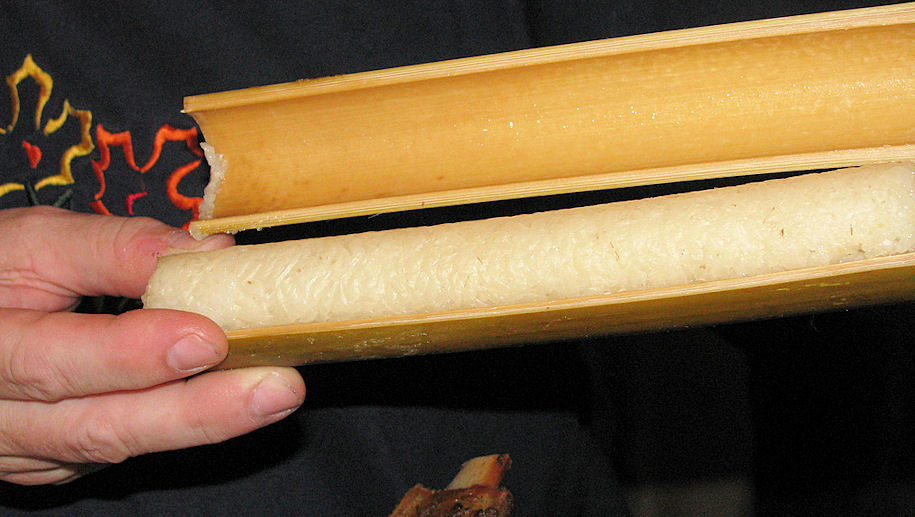
Abb.: In Bambus gekochter Reis, Buluowan, Taroko National Park (太魯閣國家公園),
Taiwan (台灣)
[Bildquelle: Arthur Chapman. --
http://www.flickr.com/photos/arthur_chapman/3354189653/. -- Zugriff am
2009-09-11. --
Creative
Commons Lizenz (Namensnennung, keine kommerzielle Nutzung, share alike)]
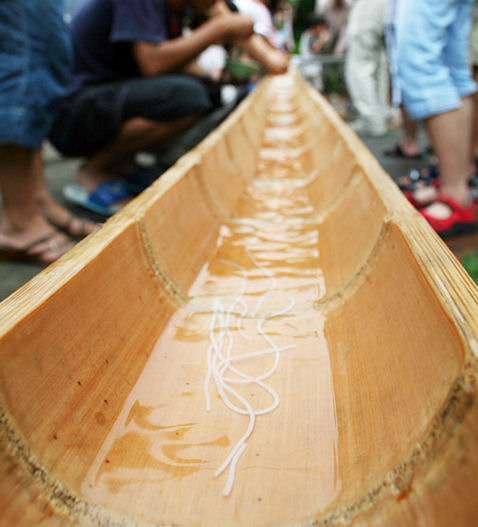
Abb.: Bambusrinne mit entfernten Diaphragmen, Nagashi-Somen (流しそうめん) (dabei
werden Nudeln in einer Bambusrinne treiben gelassen, man sucht die Nudeln mit
den Essstäbchen zu fangen und dann zu essen)
[Bildquelle: d'n'c. --
http://www.flickr.com/photos/25232127@N00/245794628. -- Zugriff am
2009-09-25. --
Creative Commons Lizenz (Namensnennung, share alike)]
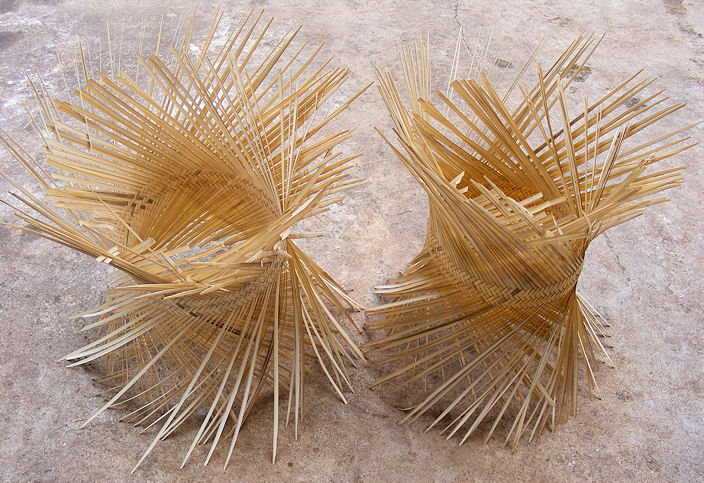
Abb.: Behälter für Klebereis - กระติบข้าว - Nordosttthailand (อีสาน),
Zwischenstadium der Produktion
[Bildquelle: Mattes / Wikimedia. -- Creative Commons Lizenz
(Namensnnenung)]
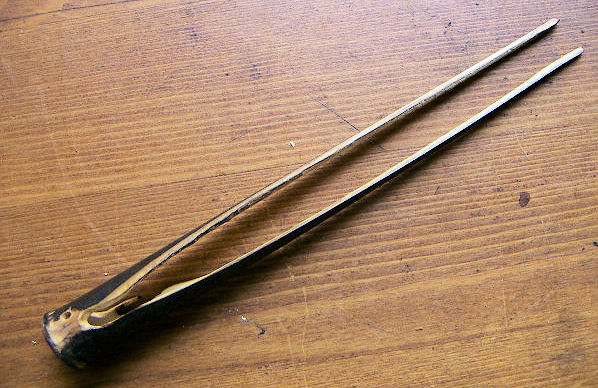
Abb.: Pinzette aus Bambus
[Bildquelle: Jordi Coll Costa / Wikimedia. -- GNU FDLicense]
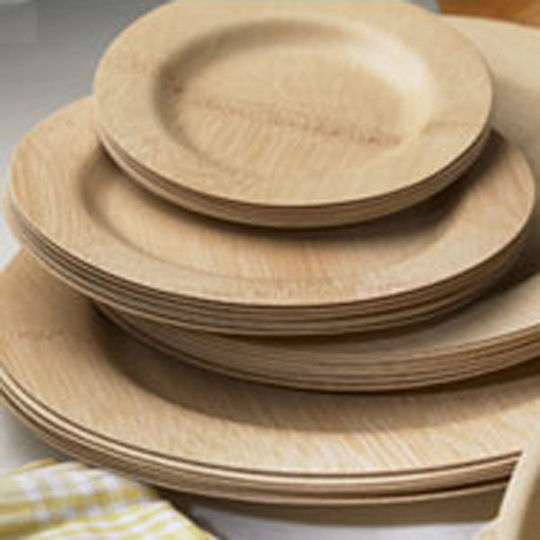
Abb.: Bambus-Wegwerfteller
[Bildquelle: re-modern.com. --
http://www.flickr.com/photos/re-modern/2674824392/ . -- Zugriff am
2009-09-11. --
Creative
Commons Lizenz (Namensnennung,keine kommerzielle Nutzung, keine
Bearbeitung)]
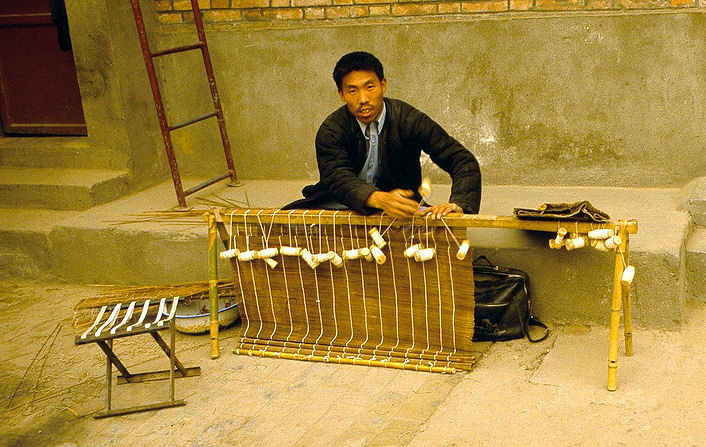
Abb.: Bambusweber, Xi'an (西安),
China (中国)
[Bildquelle: kattebelletje. --
http://www.flickr.com/photos/kattebelletje/3202203912/ . -- Zugriff am
2009-09-13. --
Creative Commons Lizenz (Namensnennung, keine kommerzielle Nutzung)]
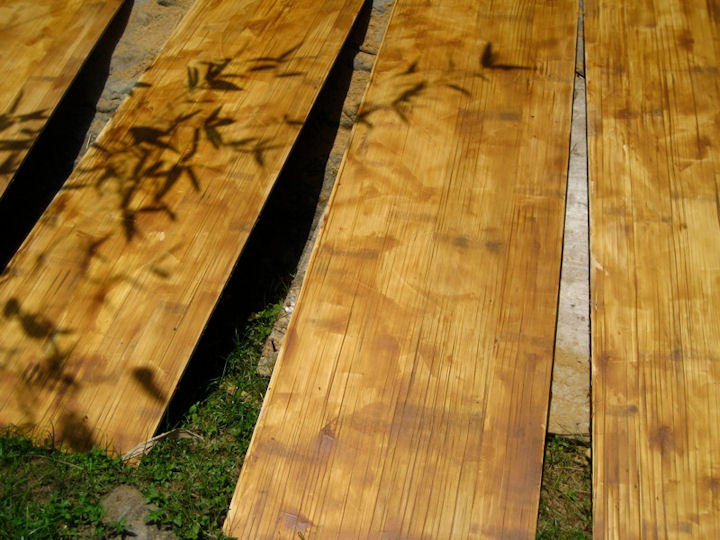
Abb.: Bambusbretter, Buglas Bamboo Institute, Duamguete, Philippinen
"These boards were each made from one half poll section of bamboo. They have
been flattened and filled and are now catching a tan as they dry in preparation
for planing. "
[Bildquelle: suvajack. --
http://www.flickr.com/photos/suvajack/1617675769/ . -- Zugriff am
2009-09-14. --
Creative Commons Lizenz (Namensnennung)]
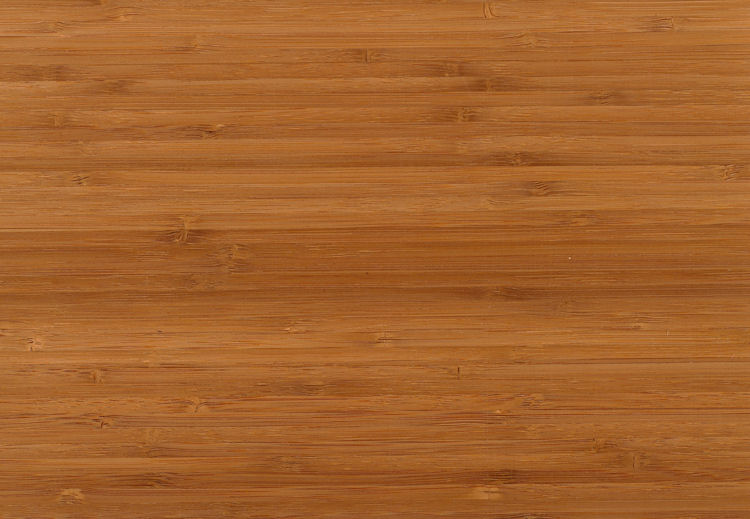
Abb.: Bambusfurnier
[Bildquelle: böhringer friedrich / Wikipedia. --
Creative Commons
Lizenz (Namensnennung, share alike)]
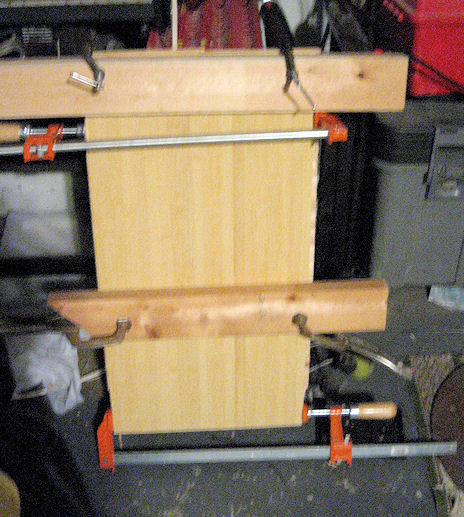
Abb.: Bambus-Laminat
[Bildquelle: Kelt. --
http://www.flickr.com/photos/trevelyan_bloomfield/2294594777/. -- Zugriff am
2009-10-08. --
Creative
Commons Lizenz (Namensnennung, keine kommerzielle Nutzung, share alike)]
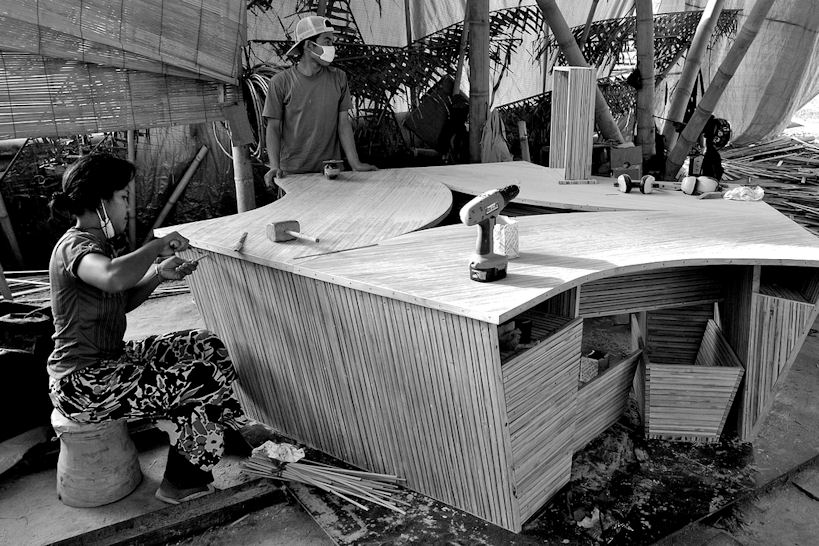
Abb.: Finish, Möbel aus Bambus, PT bamboo factory, Sibang Kaja, Bali, Indonesien
[Bildquelle: jsigharas. --
http://www.flickr.com/photos/jsigharas/2132296464/in/set-72157605942819126/
. -- Zugriff am 2009-09-14. --
Creative
Commons Lizenz (Namensnennung, keine kommerzielle Nutzung, share alike)]
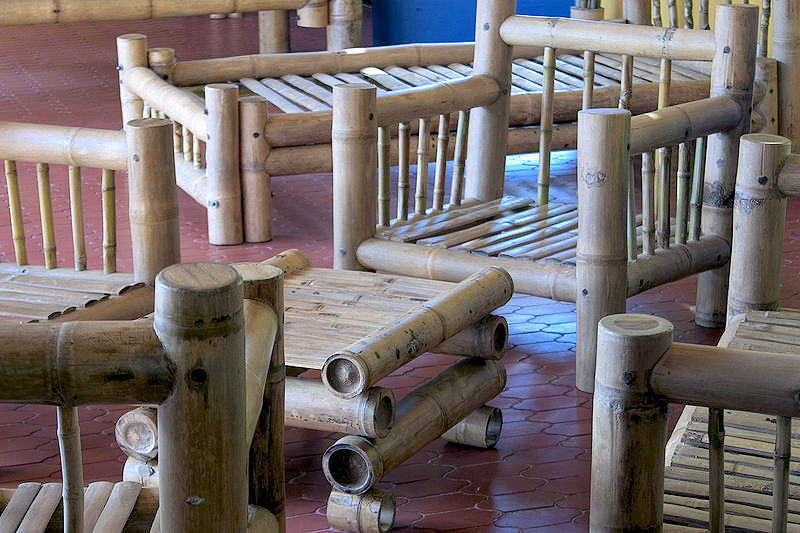
Abb.: Möbel aus Guadua-Bambus, Centro Nacional para el Estudio
Bambú-Guadua, Córdoba, Quindío, Kolumbien
[Bildquelle: Shaun McRae / Wi9kipedia. --
Creative Commons
Lizenz (Namensnennung)]
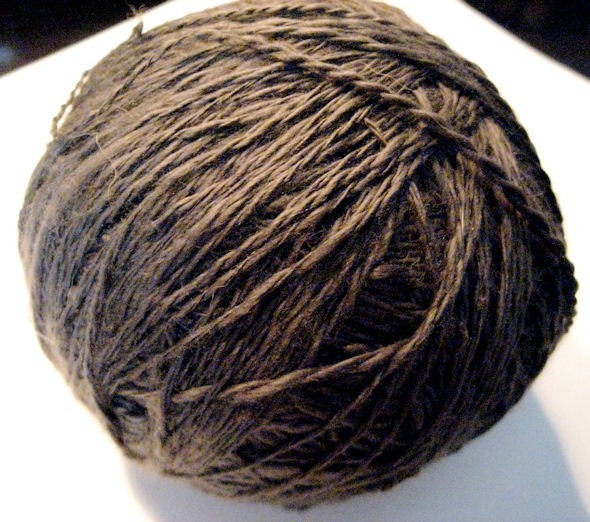
Abb.: Schnur aus verkohltem Bambus gezwirnt
[Bildquelle: moria. --
http://www.flickr.com/photos/moria/2355905928/. -- Zugriff am 2009-09-11. --
Creative Commons
Lizenz (Namensnennung)]
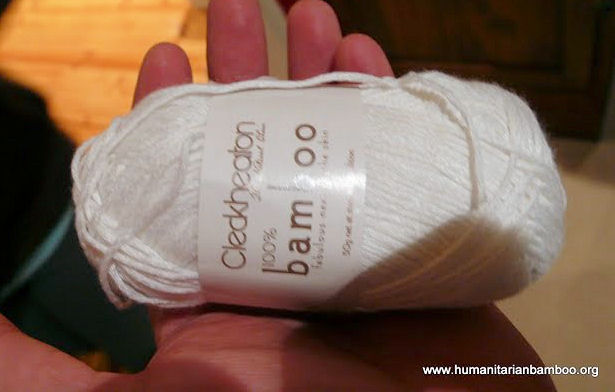
Abb.: Bambus-Wolle
[Bildquelle: humanitarianbamboo.org. --
http://picasaweb.google.com/humanitarianbamboo/BambooClothing#5292513866469765122.
-- Zugriff am 2009-09-28. --
Creative Commons
Lizenz (Namensnennung, keine kommerzielle Nutzung, share alike)]
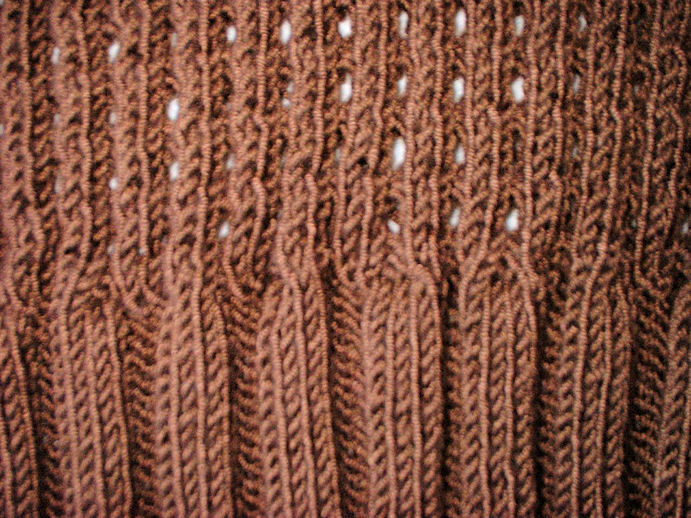
Abb.: Strickware aus Bambuswolle
[Bildquelle: Ryj / Wikimedia. -- Public domain]

Abb.: Unterwäsche aus Bambusfaser
[Bildquelle: humanitarianbamboo.org. -- http://picasaweb.google.com/humanitarianbamboo/BambooClothing#5292081790795270722 . -- Zugriff am 2009-09-28. -- Creative Commons Lizenz (Namensnennung, keine kommerzielle Nutzung, share alike)]
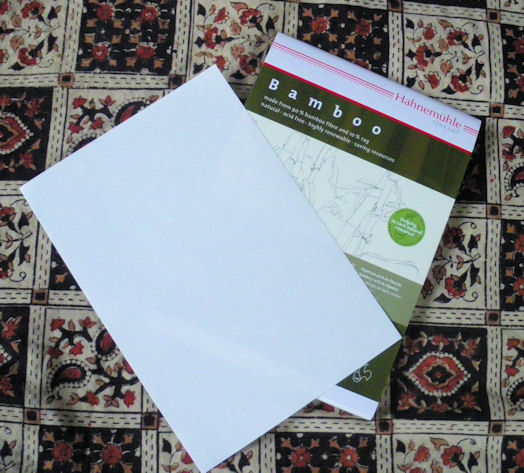
Abb.: Papier aus 90% Bambusfasern und 10% Hadern, säurefrei, naturweiß, der
Firma ™Hahnemühle
[Bild: A. Payer, 2009]
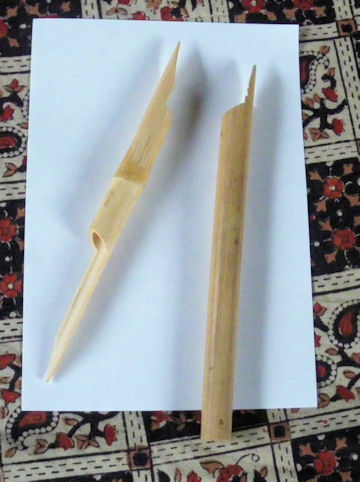
Abb.: Einfache Bambusfedern, China
[Bild: A. Payer, 2009]
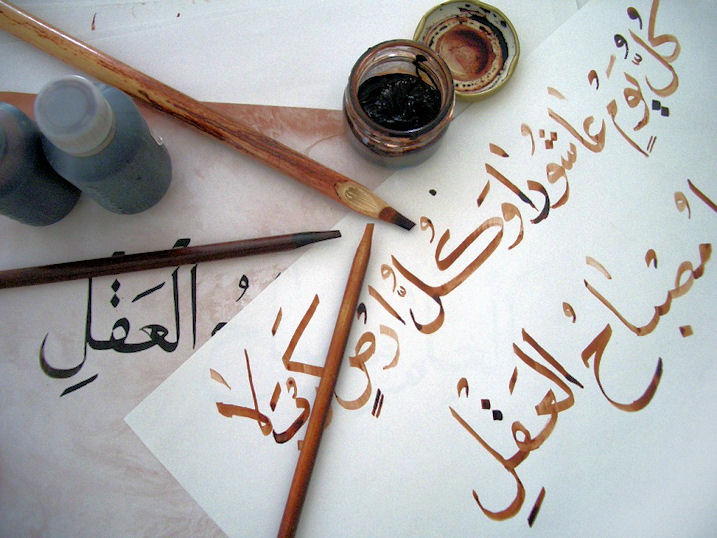
Abb.: Bambusstifte für arabische Kaligraphie
[Bildquelle: Aieman Khimji / Wikipedia. --
Creative Commons
Lizenz (Namensnennung)]

Abb.: Bambus-Malpinsel
[Bildquelle: shotyoudown. --
http://www.flickr.com/photos/thecameragirl/3051915537/in/photostream/ . --
Zugriff am 2009-09-14. --
Creative
Commons Lizenz (Namensnennung, keine kommerzielle Nutzung, keine
Bearbeitung)]
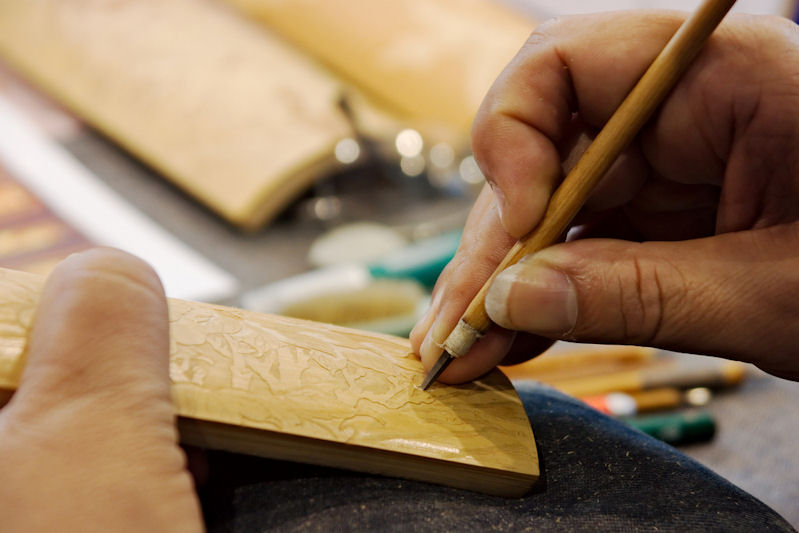
Abb.: Bambusschnitzer, Nanjing (南京), China (中国)
[Bildquelle: springm / Markus Spring. --
http://www.flickr.com/photos/springm/3056514213/ . -- Zugriff am 2009-09-13.
-- Creative
Commons Lizenz (Namensnennung, keine kommerzielle Nutzung, share alike)]
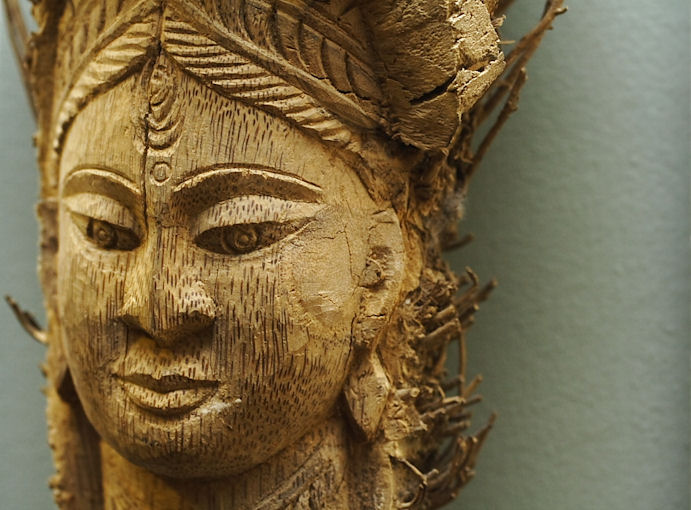
Abb.: Hindu--Göttin Durga (दुर्गा), geschnitzt aus einer Bambuswurzel, Indien
[Bildquelle: Niharb. --
http://www.flickr.com/photos/nbhattac/3186490095/. -- Zugriff am 2009-10-08.
-- Creative
Commons Lizenz (Namensnennung, keine kommerzielle Nutzung, keine
Bearbeitung)]
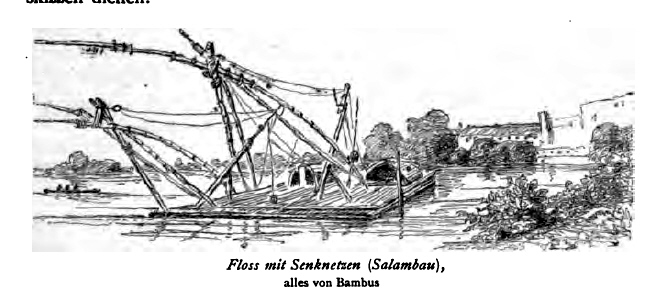
Abb.: Floß mit Senknetzen, alles von Bambus, Salambao, Philippinen
[Quelle von Abb. und Text: Jagor, Fedor <1816-1900>: Reisen in den Philippinen. -- Berlin, Weidmann, 1873. -- XVI, 381 S., Ill. ; 22 cm. -- S. 37. -- Online: http://www.archive.org/details/reisenindenphil00jagogoog. -- Zugriff am 2009-10-06]
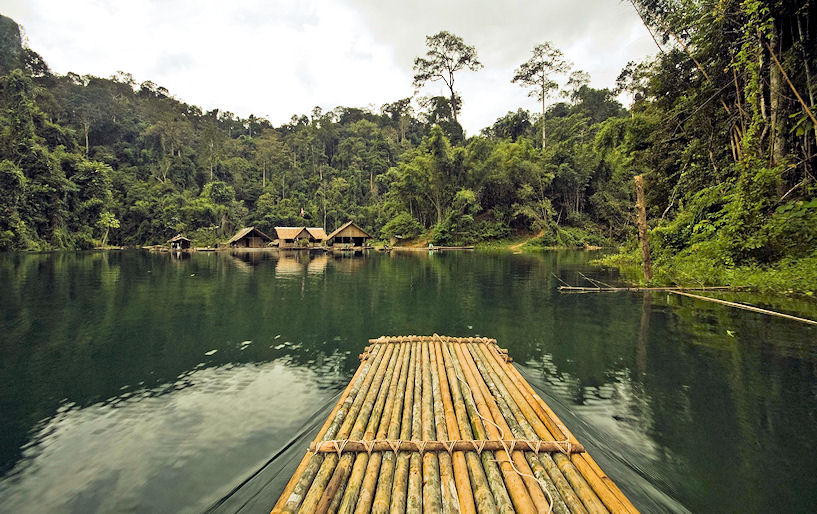
Abb.: Bambusfloß, Chiao Lan (เชี่ยวหลาน) Lake Khao Sok National Park (เขาสก),
Surat Thani (สุราษฎร์ธานี),Thailand (ประเทศไทย)
[Bildquelle: René Ehrhardt. --
http://www.flickr.com/photos/rene_ehrhardt/2390472699/. -- Zugriff am
2009-09-11. --
Creative Commons Lizenz (Namensnennung)]
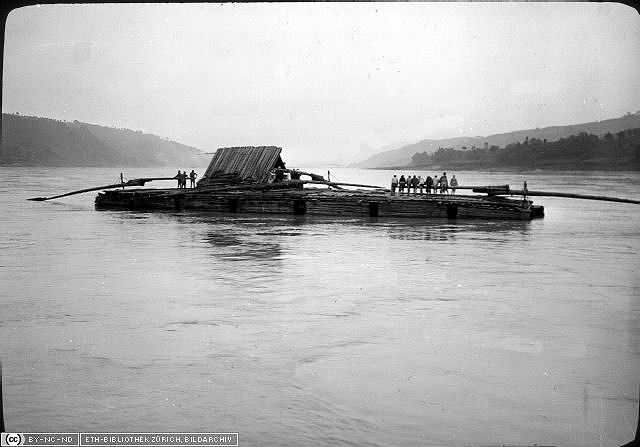
Abb.: Bambusfloß auf dem Yangtsekiang, China, 1929
[Bildquelle: Arnold Heim. --
http://www.e-pics.ethz.ch/index/ETHBIB.Bildarchiv/ETHBIB.Bildarchiv_Dia_018-054_15563.html
. -- Zugriff am 2009-09-17. --
Creative Commons
Lizenz (Namensnennung, keine kommerzielle Nutzung, keine Bearbeitung)]
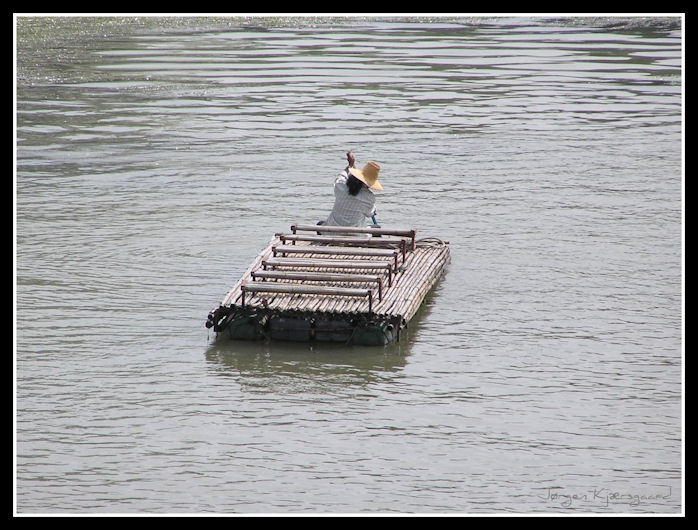
Abb.: Bambusboot, Thailand (ประเทศไทย)
[Bildquelle: jnpk1979. --
http://www.flickr.com/photos/29237999@N04/2879122783/ . -- Zugriff am
2009-09-11. --
Creative Commons Lizenz (Namensnennung, keine Bearbeitung)]

Abb.: Boot mit Auslegern von Bambus. Der obere Rand besteht nur aus einem losen
Geflecht von Palmenblättern, durch Bambusstreifen gehalten."
[Quelle von Abb. und Text: Jagor, Fedor <1816-1900>: Reisen in den Philippinen. -- Berlin, Weidmann, 1873. -- XVI, 381 S., Ill. ; 22 cm. -- S. 193. -- Online: http://www.archive.org/details/reisenindenphil00jagogoog. -- Zugriff am 2009-10-06]
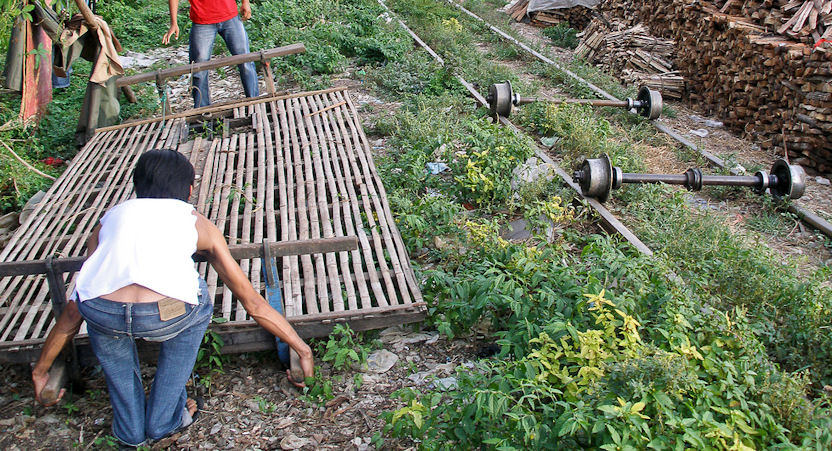
Abb.: Bambus-Schienenwagen ("bamboo train") auf aufgelassener Bahnstrecke,
Battambang (ក្រុងបាត់ដំបង), Kambodscha (ព្រះរាជាណាចក្រកម្ពុជា)
[Bildquelle: Gusjer. --
http://www.flickr.com/photos/gusjer/3086682629/ . -- Zugriff am 2009-09-11.
-- Creative Commons
Lizenz (Namensnennung)]
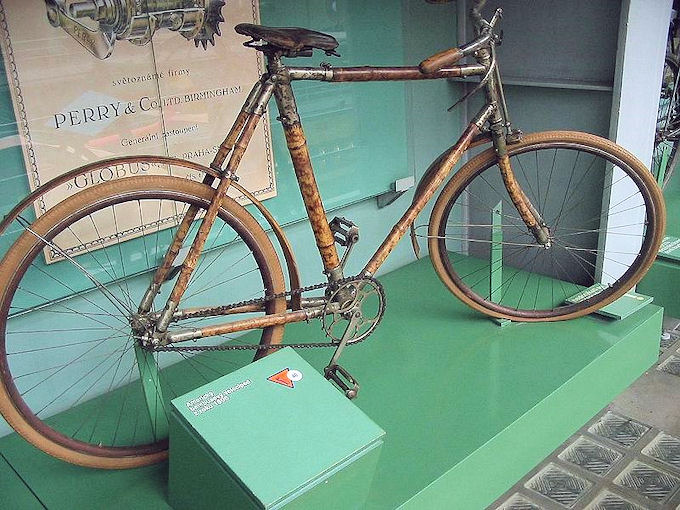
Abb.: Bambusfahrrad, USA, 1896, Muzeum Techniki w Pradze, Praha, Tschechien
[Bildquelle: Mohylek / Wikipedia. -- Public domain]
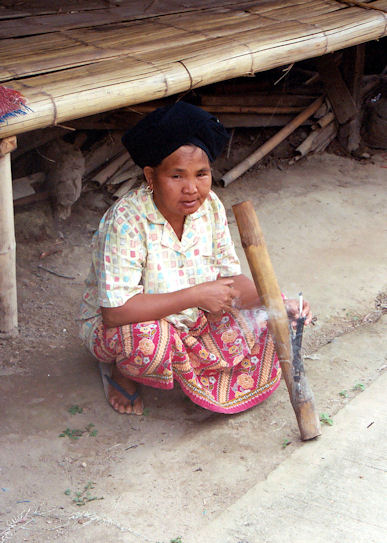
Abb.: Yao-Frau (瑤族) mit Bambus-Pfeife, Thailand (ประเทศไทย)
[Bildquelle: 9.81 meters per second squared. --
http://www.flickr.com/photos/12185911@N00/1750766825/ . -- Zugriff am
2009-09-14. --
Creative
Commons Lizenz (Namensnennung, keine kommerzielle Nutzung, keine
Bearbeitung)]
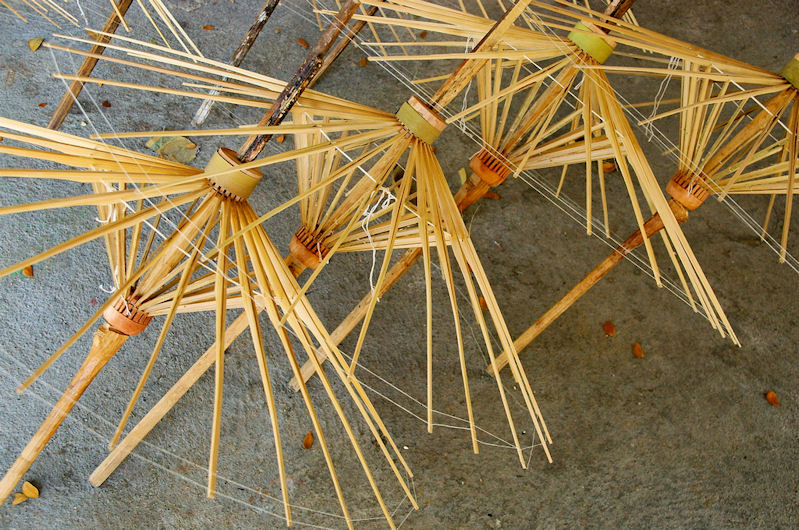
Abb.: Gestell für Bambusschirme, Chiang Mai (เจียงใหม่), Thailand (ประเทศไทย)
[Bildquelle: woowoowoo. --
http://www.flickr.com/photos/leprecon/350234119/ . -- Zugriff am 2009-09-14.
-- Creative
Commons Lizenz (Namensnennung, keine kommerzielle Nutzung, keine
Bearbeitung)]

Abb.: Taschen aus Bambus (retailpackaging.com)
[Bildquelle: Premier Packaging. --
http://www.flickr.com/photos/retail-packaging/3272067785/. -- Zugriff am
2009-09-11. --
Creative
Commons Lizenz (Namensnennung, keine kommerzielle Nutzung, share alike)]
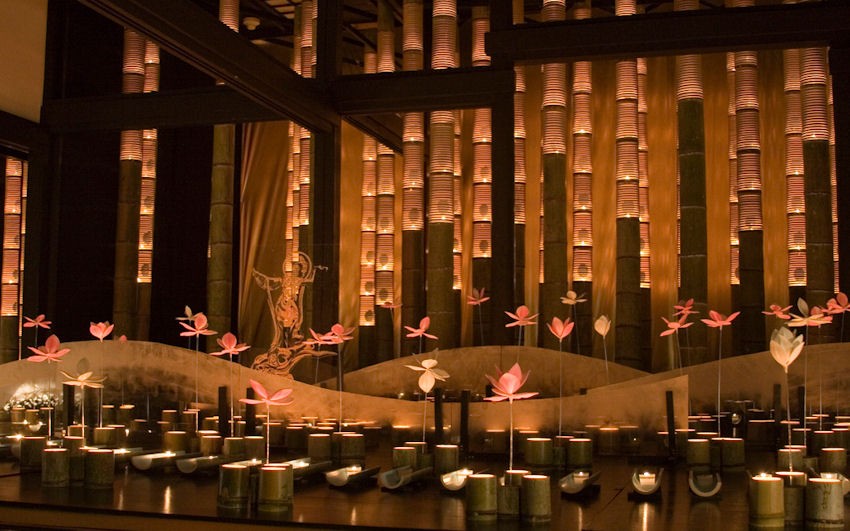
Abb.: Bambusfest, Kyushu (九州),
Japan (日本)
[Bildquelle: Bellevue Fine Art Repro (Scott). --
http://www.flickr.com/photos/panacheart/3165623840/ . -- Zugriff am
2009-09-11. --
Creative Commons Lizenz (Namensnennung, share alike)]
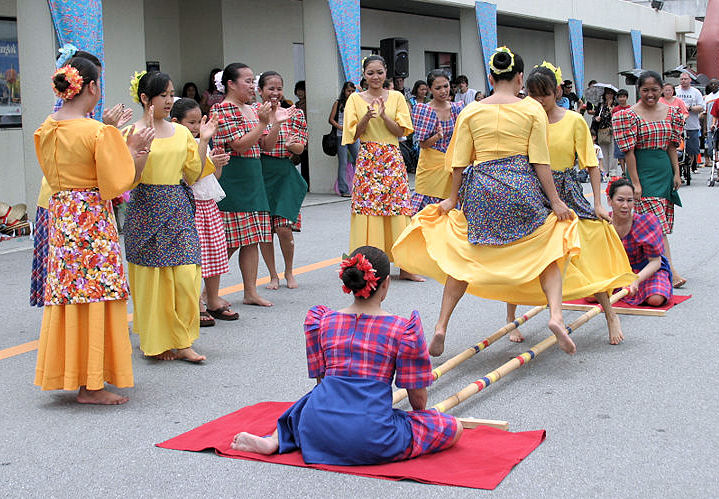
Abb.: tinikling, philippinischer Tanz mit Bambusstöcken
[Bildquelle: U.S. Air Force/Senior Airman Nestor Cruz / Wikipedia. -- Public
domain]
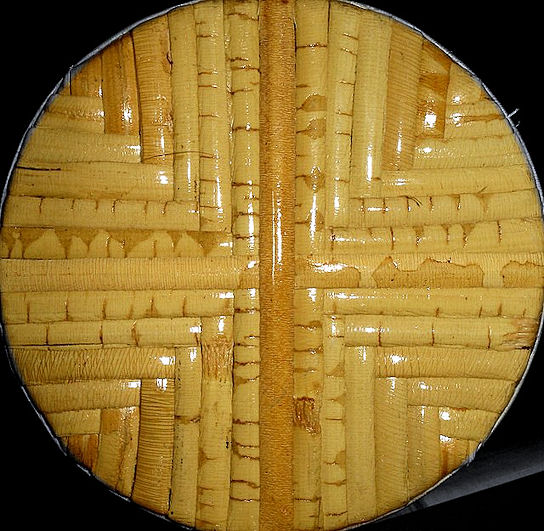
Abb.: Bambus-Trommel
[Bildquelle: allyrose18. --
http://www.flickr.com/photos/allyrose18/178574079/. -- Zugriff am
2009-09-11. --
Creative Commons Lizenz (Namensnennung, keine Bearbeitung)]
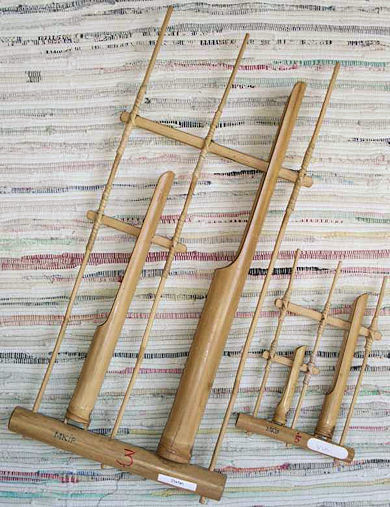
Abb.: Anklung (อังกะลุง), Indonesien
[Bildquelle: Kamillo / Wikipedia. -- GNU FDLicense]
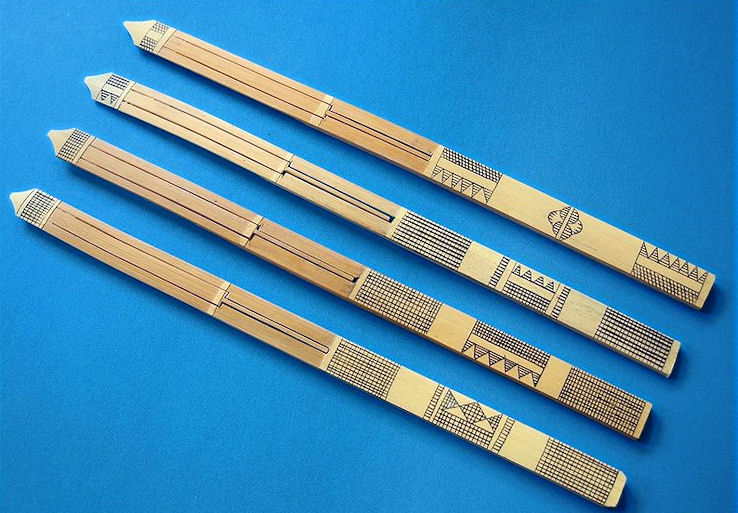
Abb.: Maultrommeln aus Bambus
[Bildquelle: Manfred Brückels / Wikipedia. -- GNU FDLicense]
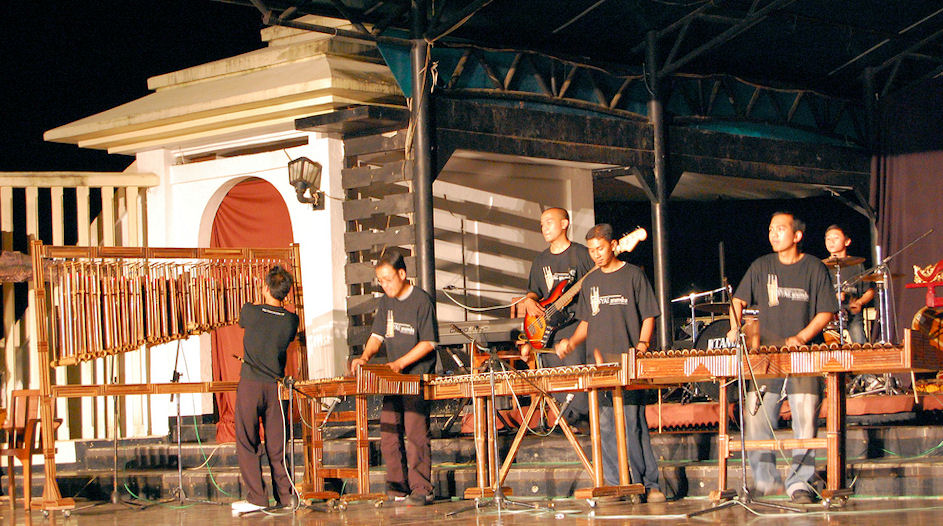
Abb.: Bambus-Xylophone etc., Taman Budaya Jawa Barat (West Java Culture Park),
Bandung, Indonesien
[Bildquelle: Ikhlasul Amal. --
http://www.flickr.com/photos/ikhlasulamal/3515168541/ . -- Zugriff am
2009-09-13. --
Creative Commons Lizenz (Namensnennung, keine kommerzielle Nutzung)]
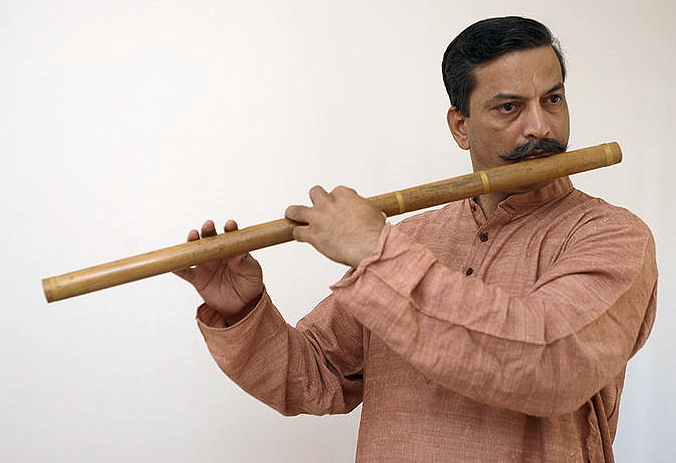
Abb.: Nityanand Haldipur
spielt Bansuri
(बांसुरी /
বাঁসুরী), die nordindische Bambusquerflöte
[Bildquelle: Krish240574 / Wikipedia. -- Public domain]
[
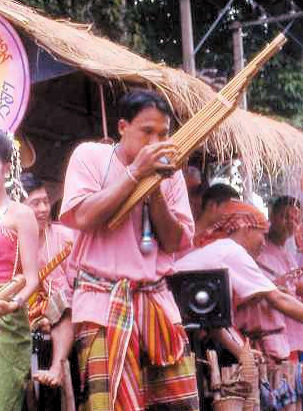
Abb.: Khaen-Spieler (แคน),
Ubon (อุบลราชธานี), Nordostthailand (อีสาน)
[Bildquelle: Macador / Wikipedia. -- GNU FDLicense]
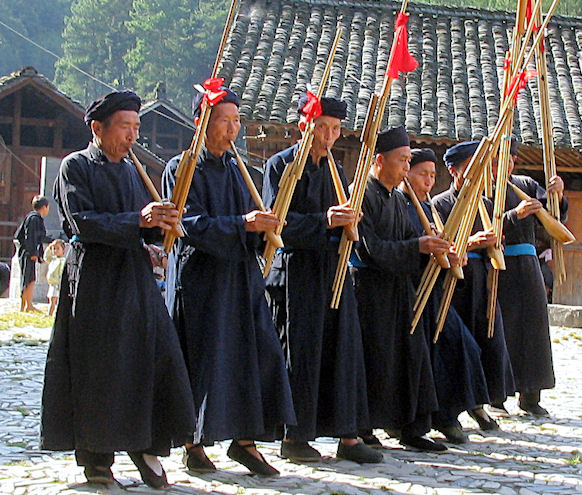
Abb.: Miao ( 苗族)
(Hmong)-Musiker aus Guizhou (贵州),
China (中国),
spielen Lusheng ( 芦笙)
auf Instrumenten verschiedener Größen
[Bildquelle: mooney47. --
http://www.flickr.com/photos/48751247@N00/315360493. -- Zugriff am
2009-09-11. --
Creative Commons Lizenz (Namensnennung)]
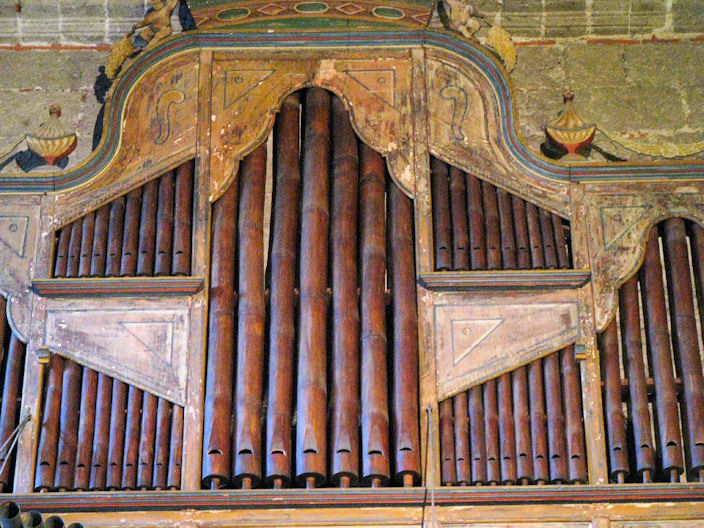
Abb.: Bambus-Kirchenorgel, Pfarrkirche St. Joseph, Las Piñas City, Philippinen
[Bildquelle: Ianz. --
http://www.flickr.com/photos/ianz/2802516204/. -- Zugriff am 2009-09-11. --
Creative Commons
Lizenz (Namensnennung, share alike)]
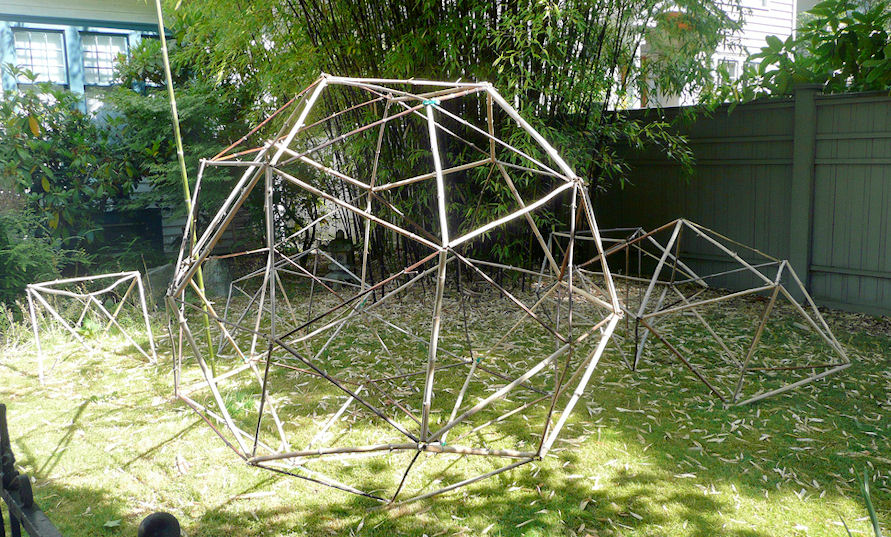
Abb.: Geodäte (geodesics) aus Bambus
[Bildquelle: FallenPegasus. --
http://www.flickr.com/photos/fallenpegasus/2727750966/ . -- Zugriff am
2009-09-13. --
Creative Commons Lizenz (Namensnennung, keine kommerzielle Nutzung)]
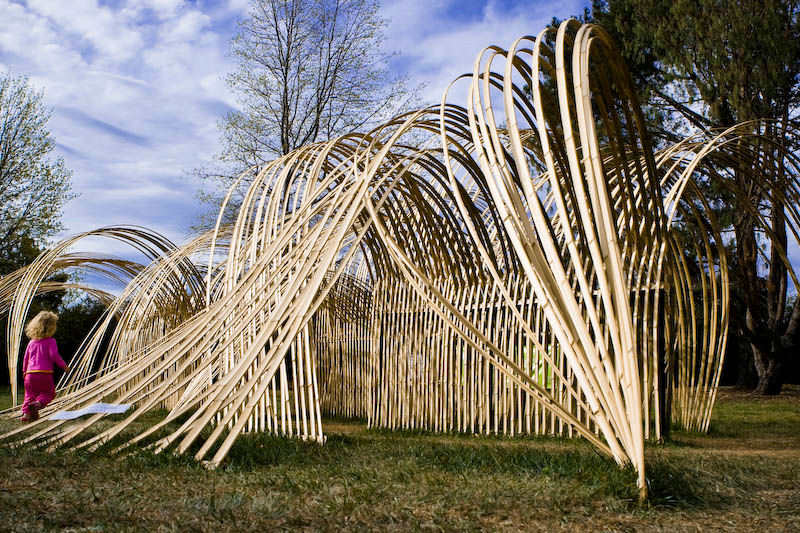
Abb.: Bambusplastik, Floriade2007, Canberra, Australien
[Bildquelle: laRuth. --
http://www.flickr.com/photos/laruth/1505390808/. -- Zugriff am 2009-09-13.
-- Creative
Commons Lizenz (Namensnnenung, keine kommerzielle Nutzung, keine
Bearbeitung)]
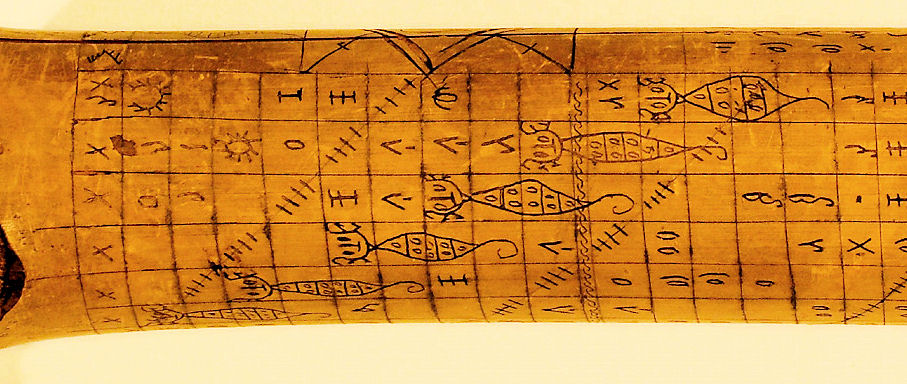
Abb.: Porhalaan, ein magischer Zauberkalender der Batak, Sumatra, Indonesien
<Ausschnitt>
[Bildquelle: Leander Seige / Wikimedia. -- GNU FDLicense]
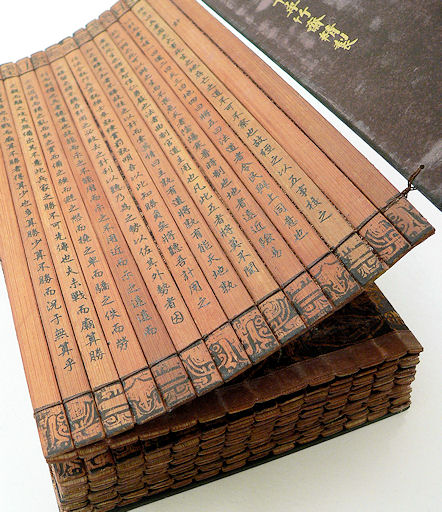
Abb.: Bambus-Buch (jiăndú = 简牍):
Sunzi (孫子):
„Die Kunst des Krieges“ (孫子兵法)
[Bildquelle: vlasta2. --
http://www.flickr.com/photos/bluefootedbooby/370458424/. -- Zugriff am
2009-09-11. --
Creative
Commons Lizenz (Namensnennung, keine kommerzielle Nutzung, keine
Bearbeitung)]

Abb.: Bambus als Tätowierstift, Ko Samui (เกาะสมุย),
Thailand (ประเทศไทย)
[Bildquelle: Robert Scales. --
http://www.flickr.com/photos/raincitystudios/2681992219/. -- Zugriff am
2009-09-11. --
Creative
Commons Lizenz (Namensnennung, keine kommerzielle Nutzung, share alike)]
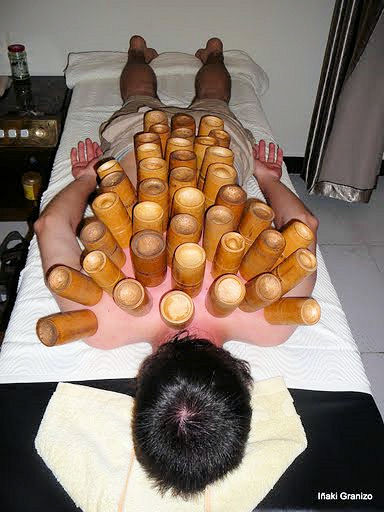
Abb.: Bambus-Schröpfköpfe / Saugnäpfe (拔罐), China
[Bildquelle: Iñaki. -- http://picasaweb.google.com/lh/view?q=bambu&psc=G&filter=1&imglic=creative_commons#5369048839081578194. -- Zugriff am 2009-09-30. -- Creative Commons Lizenz (Namensnennung, keine kommerzielle Nutzung, keine Bearbeitung)]